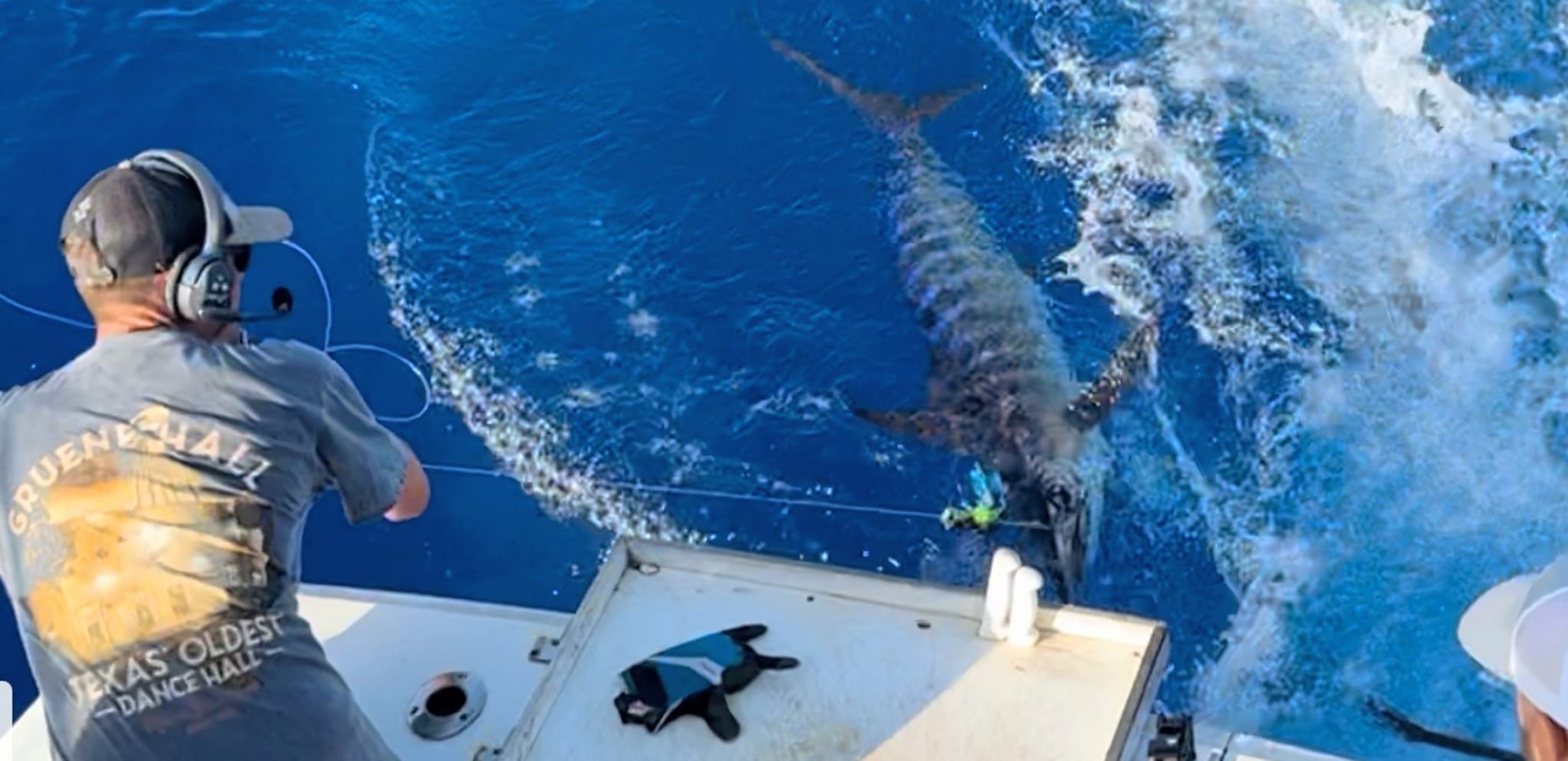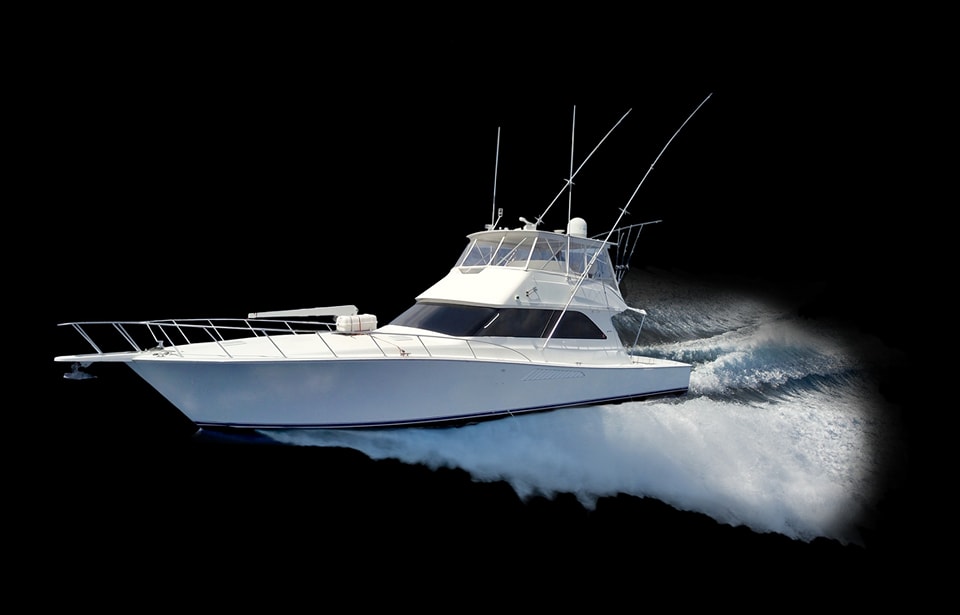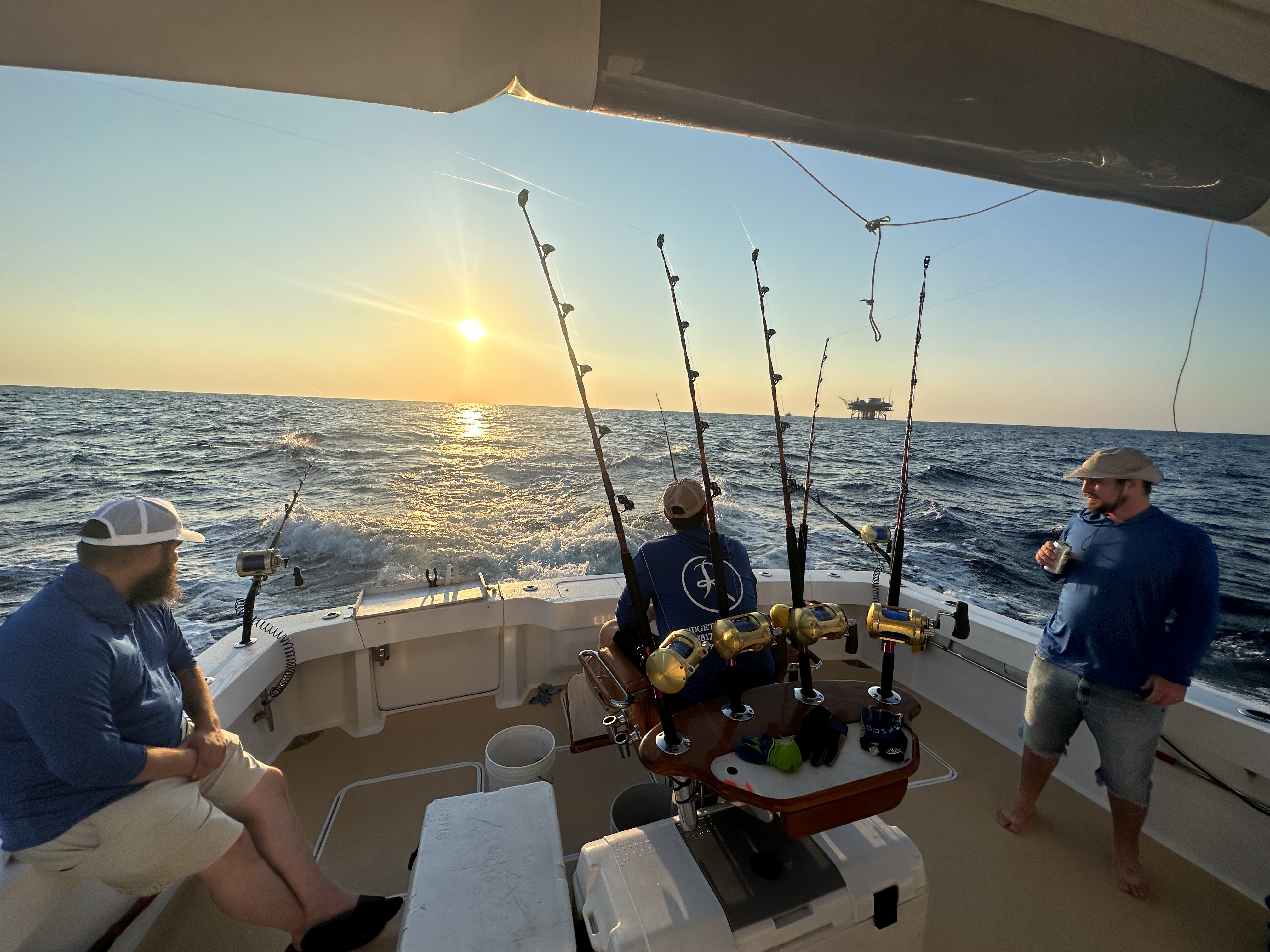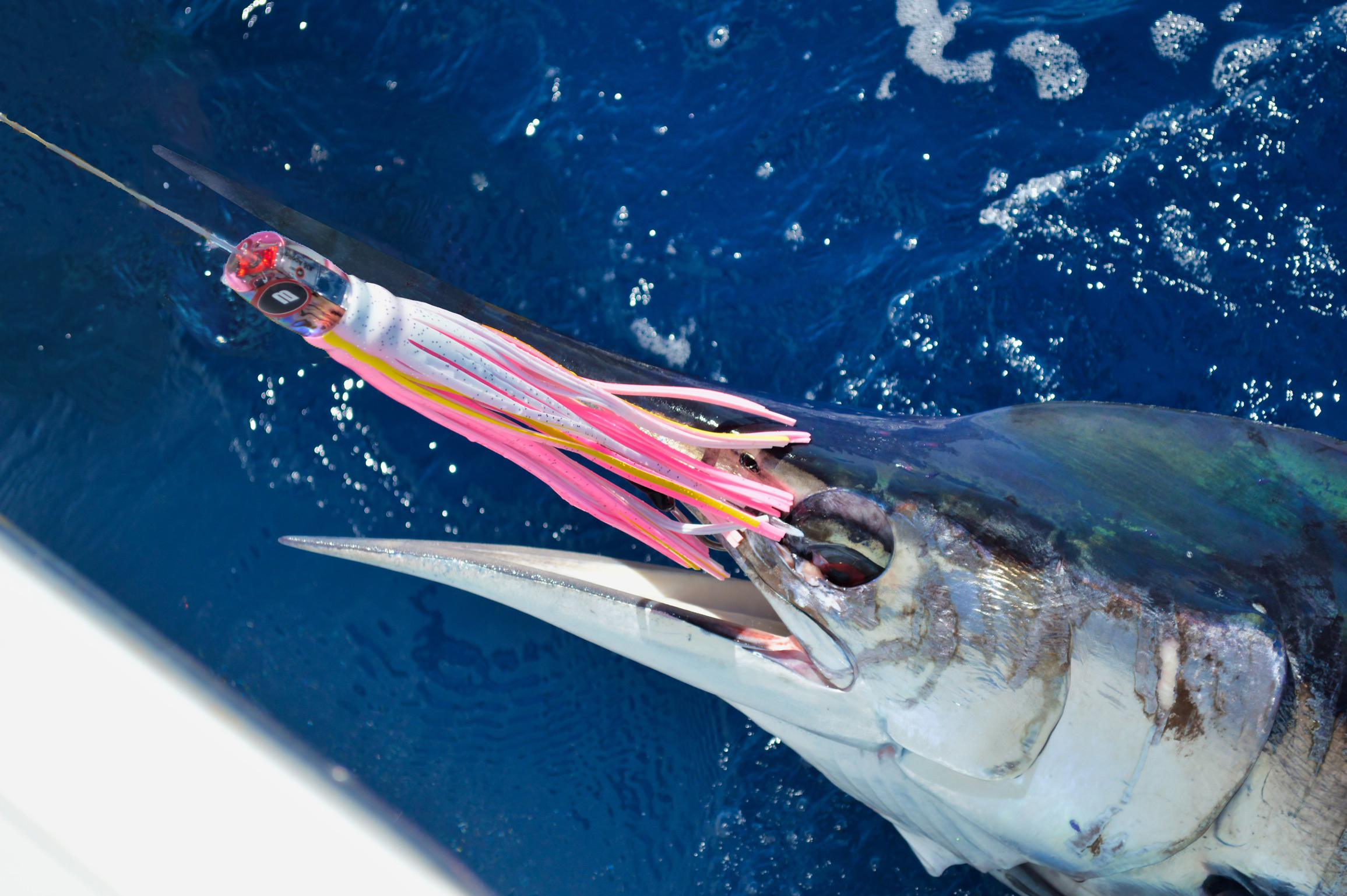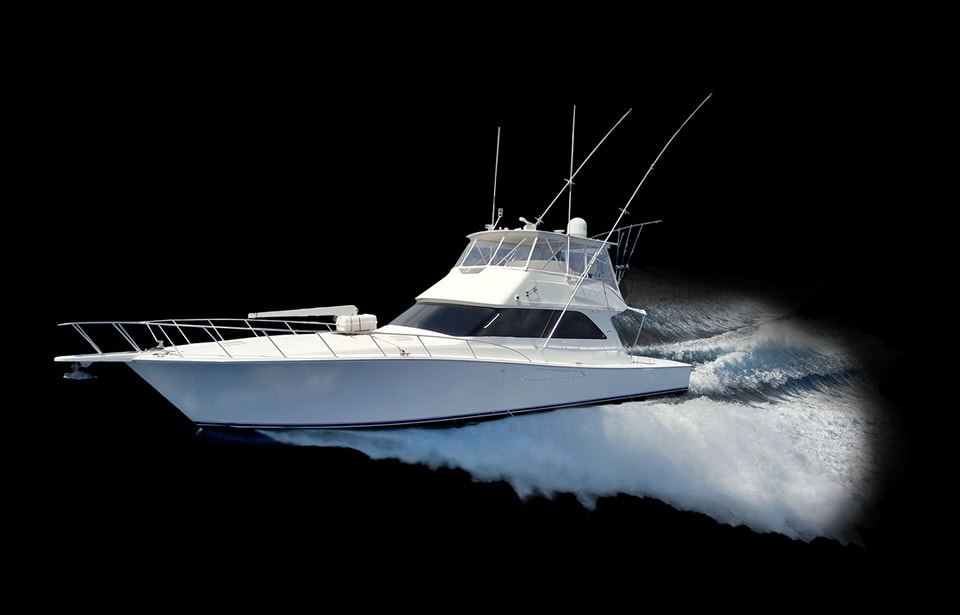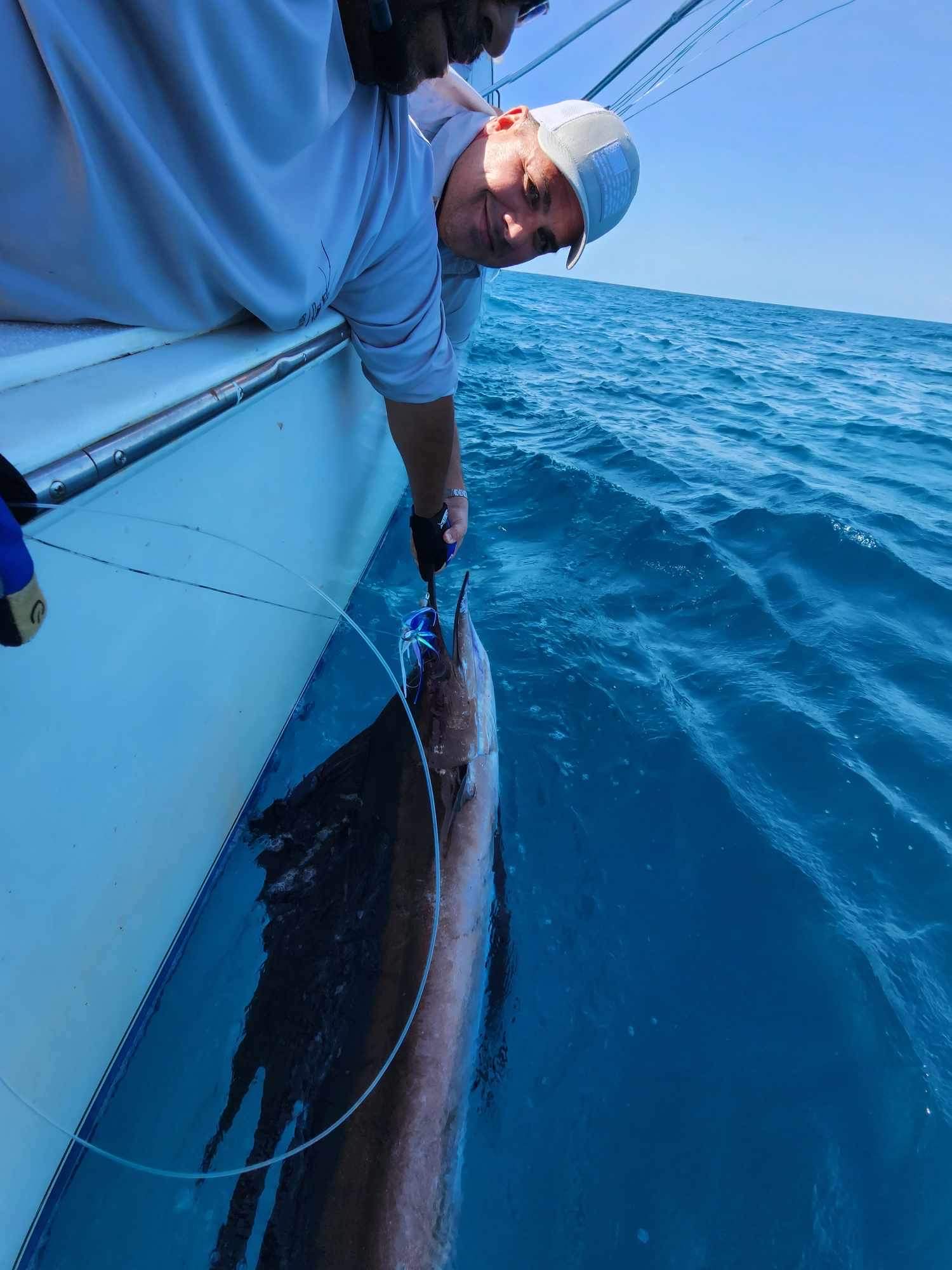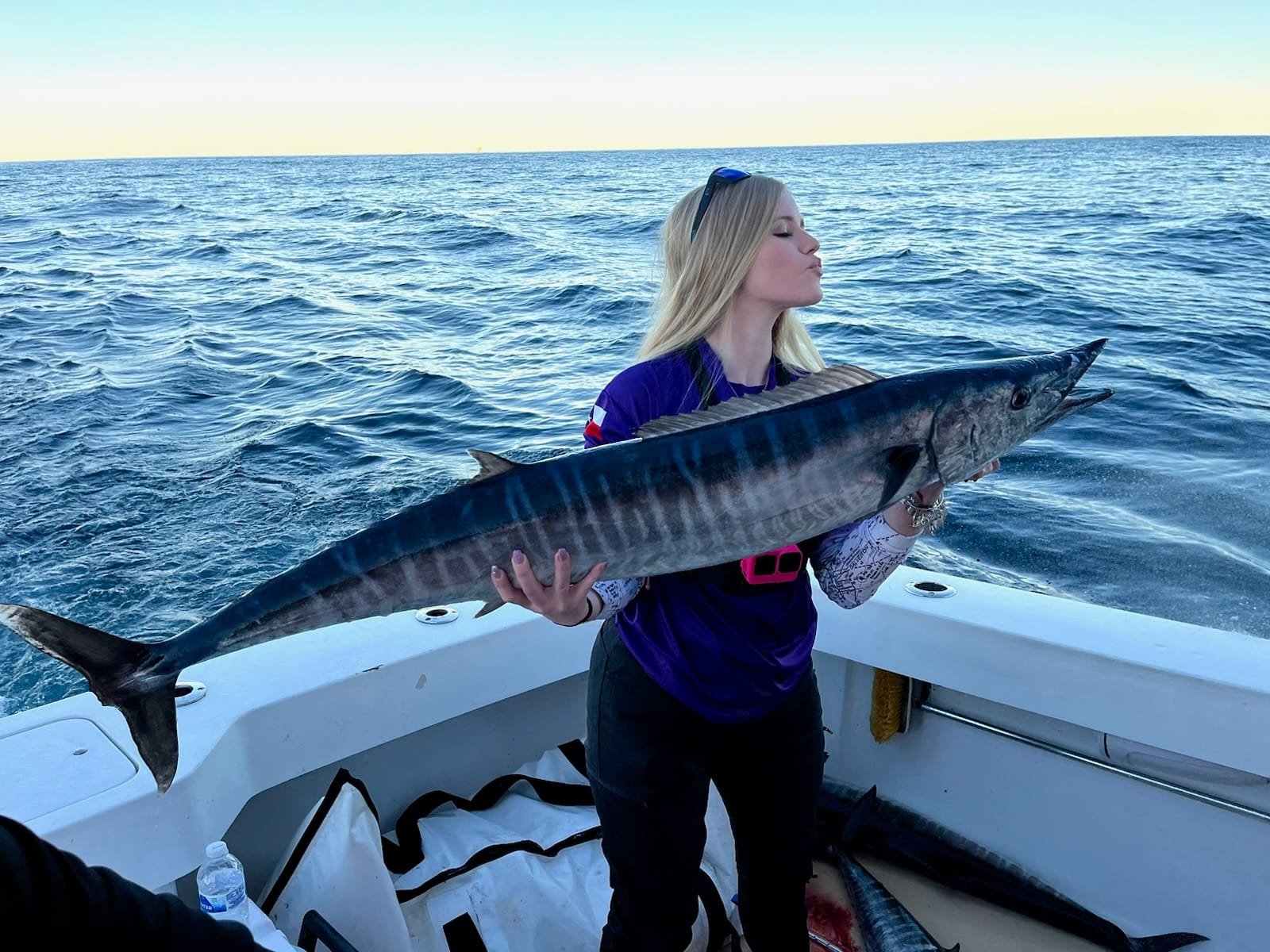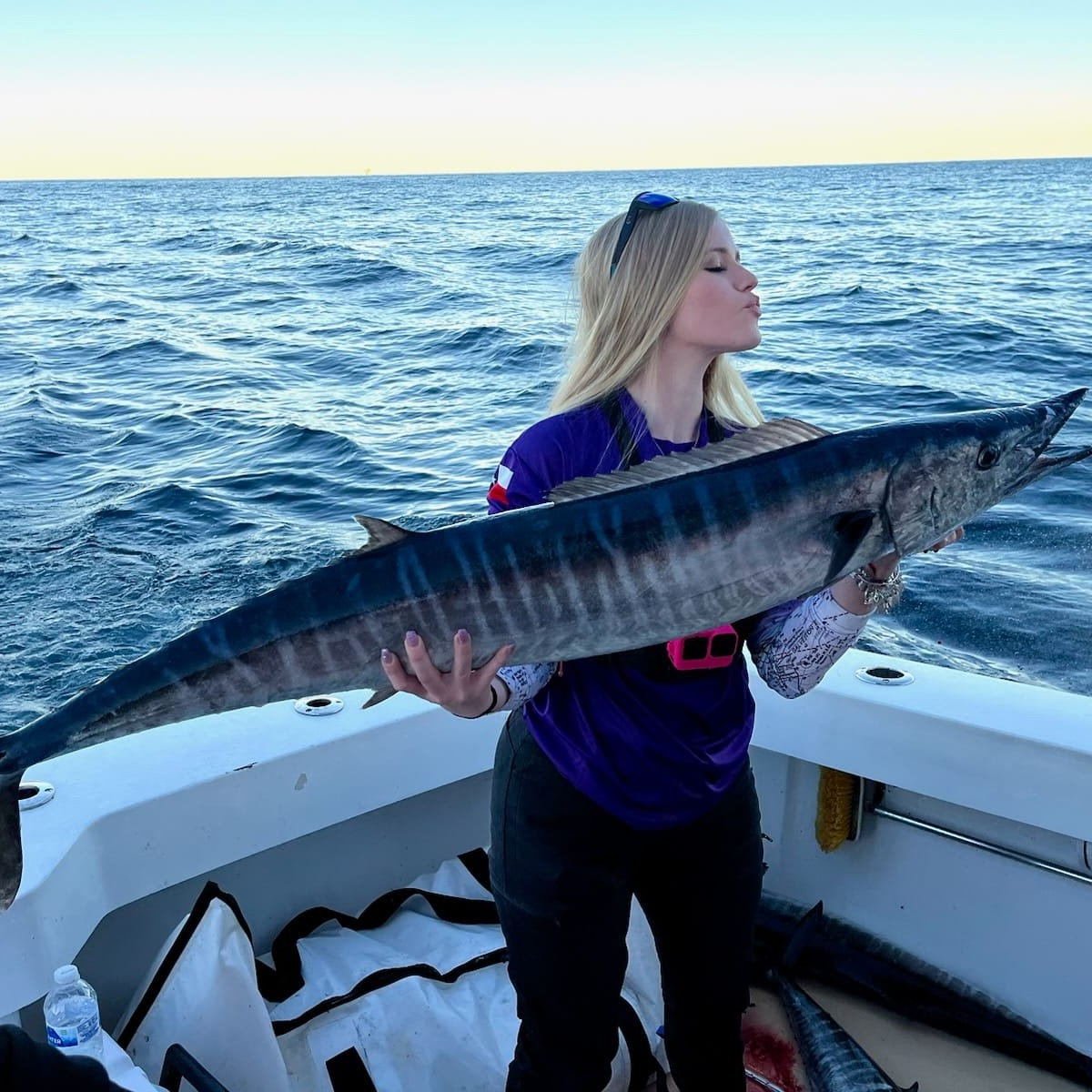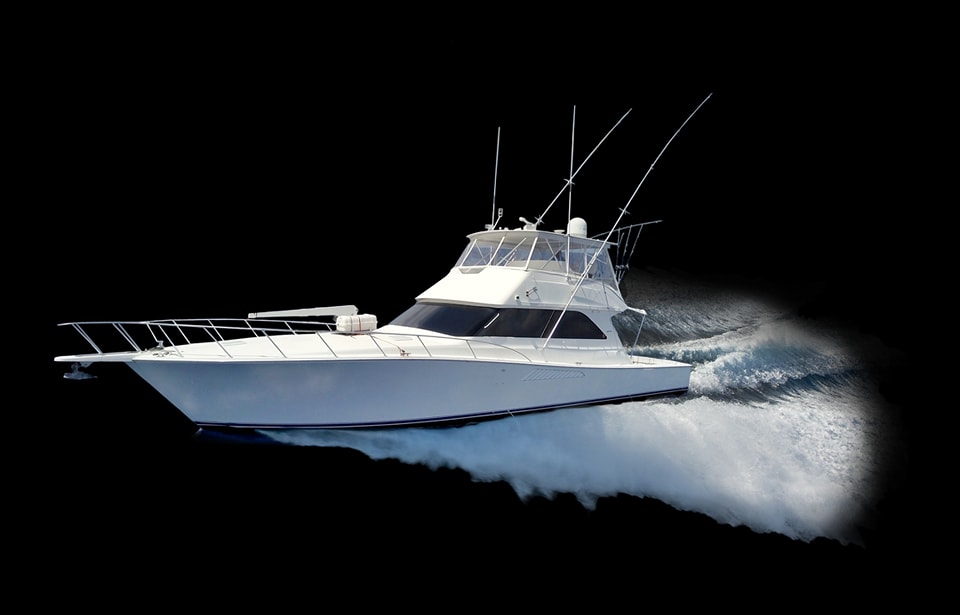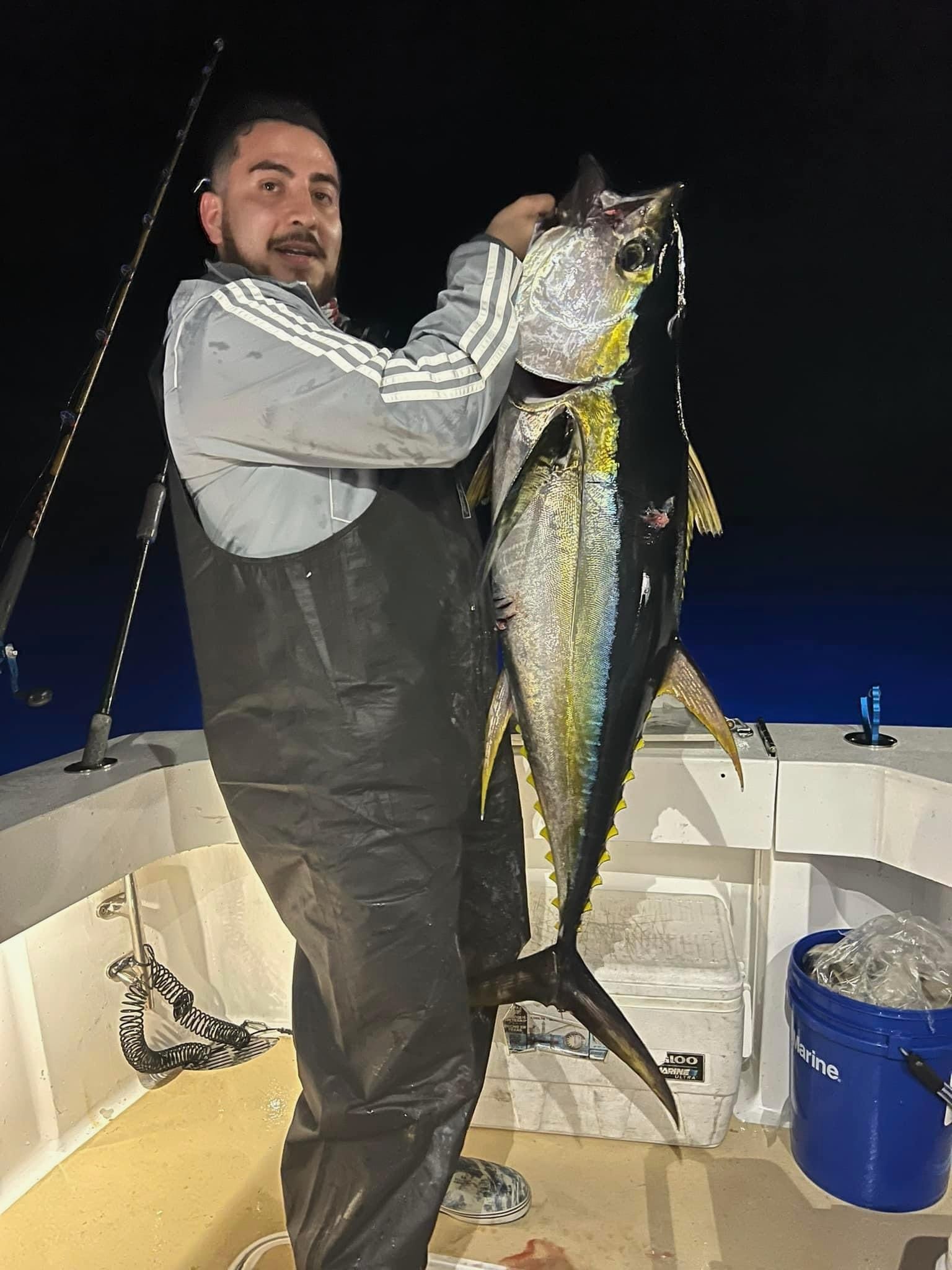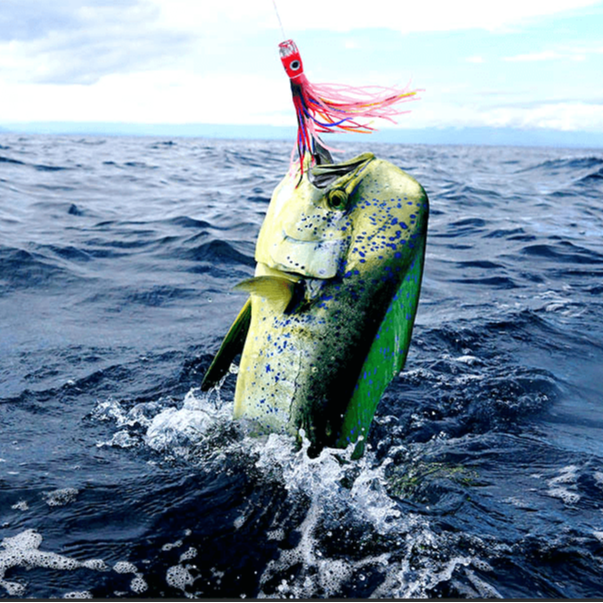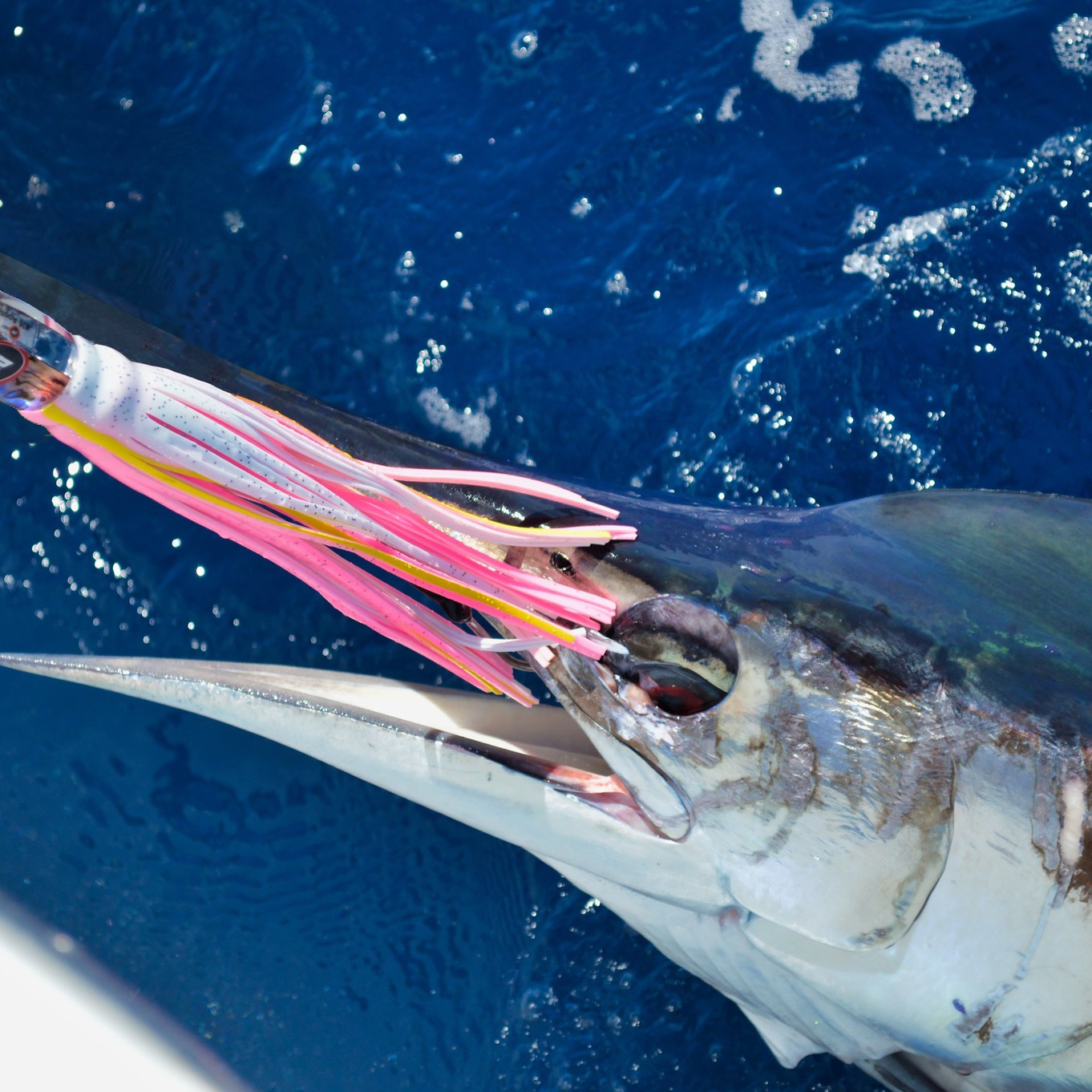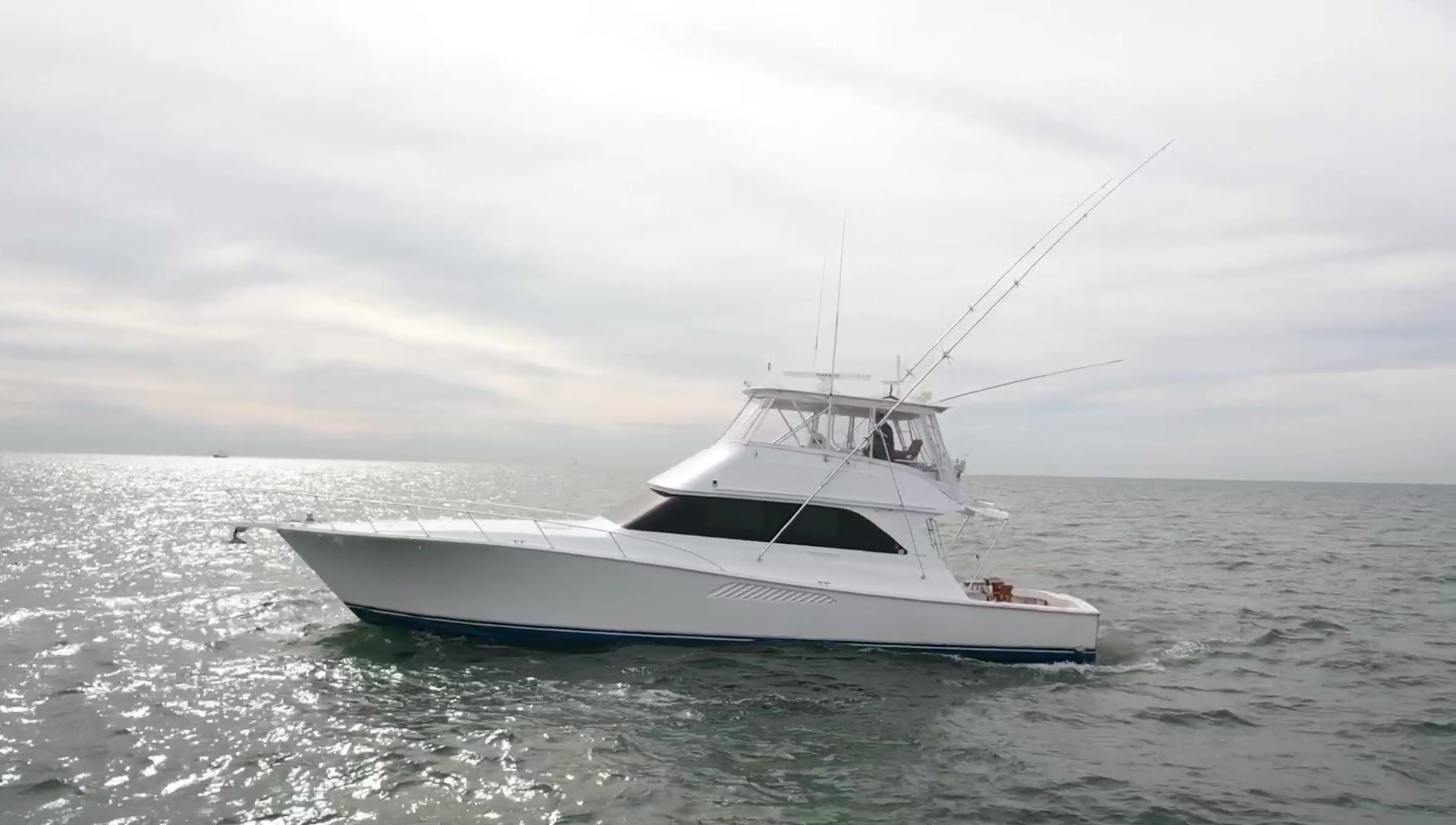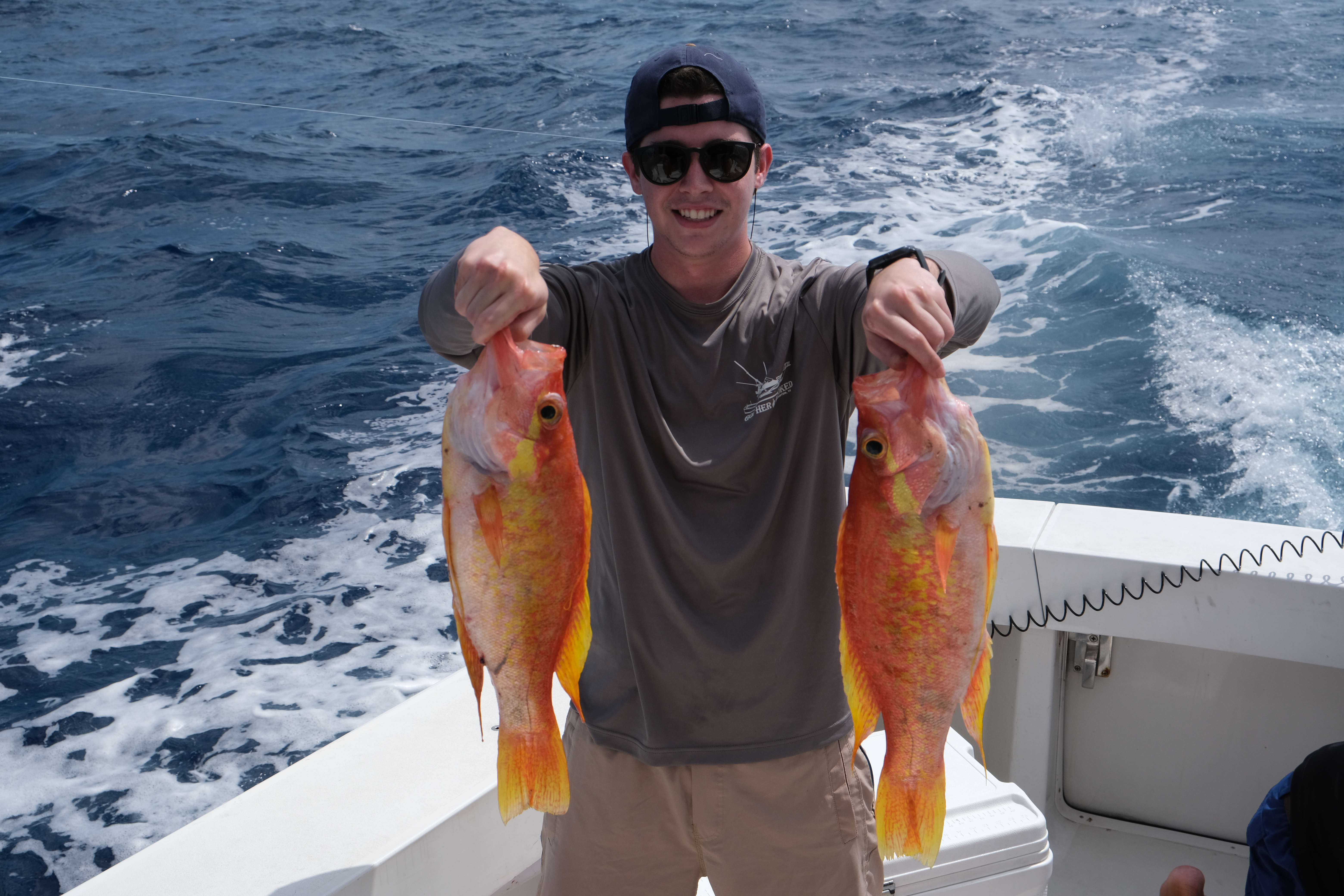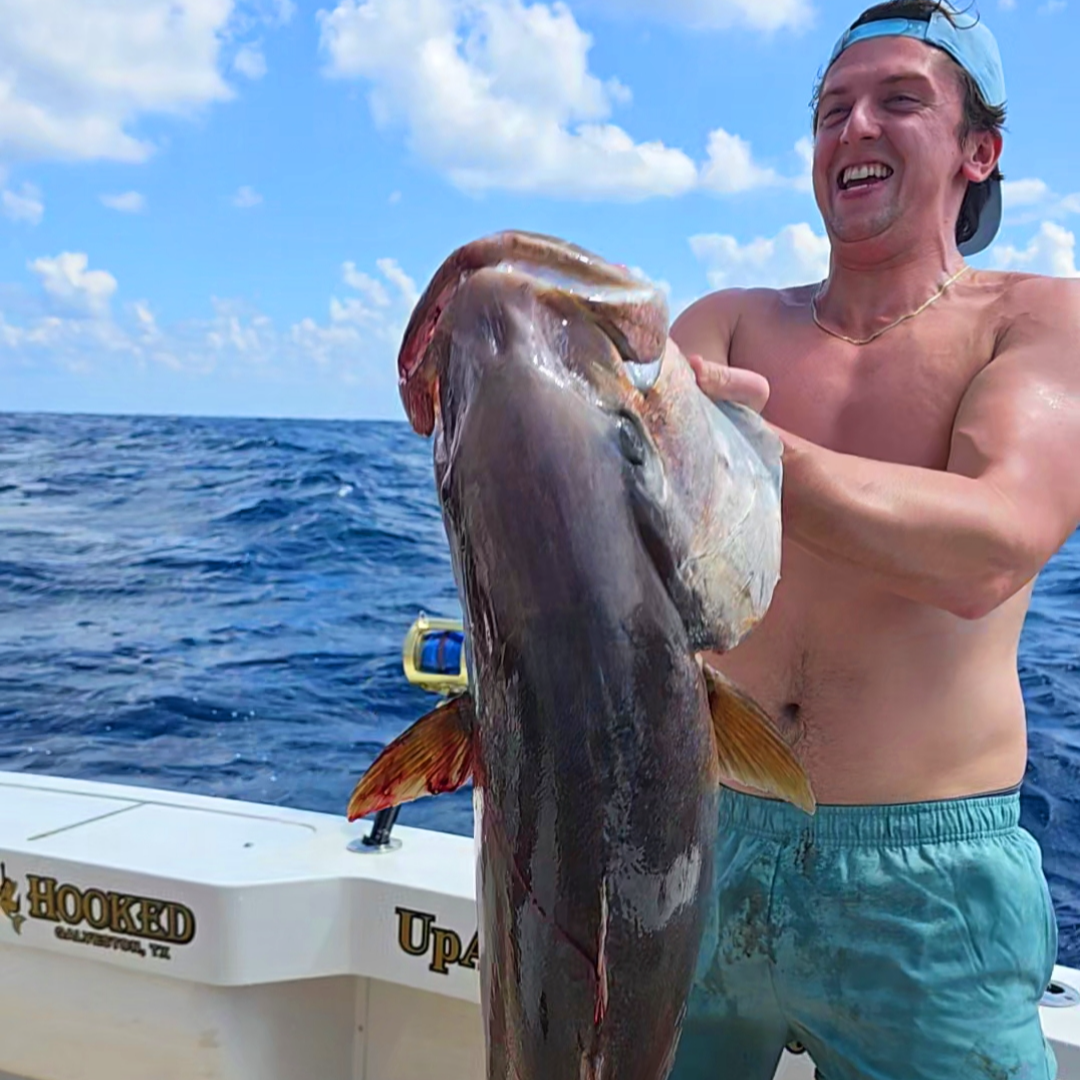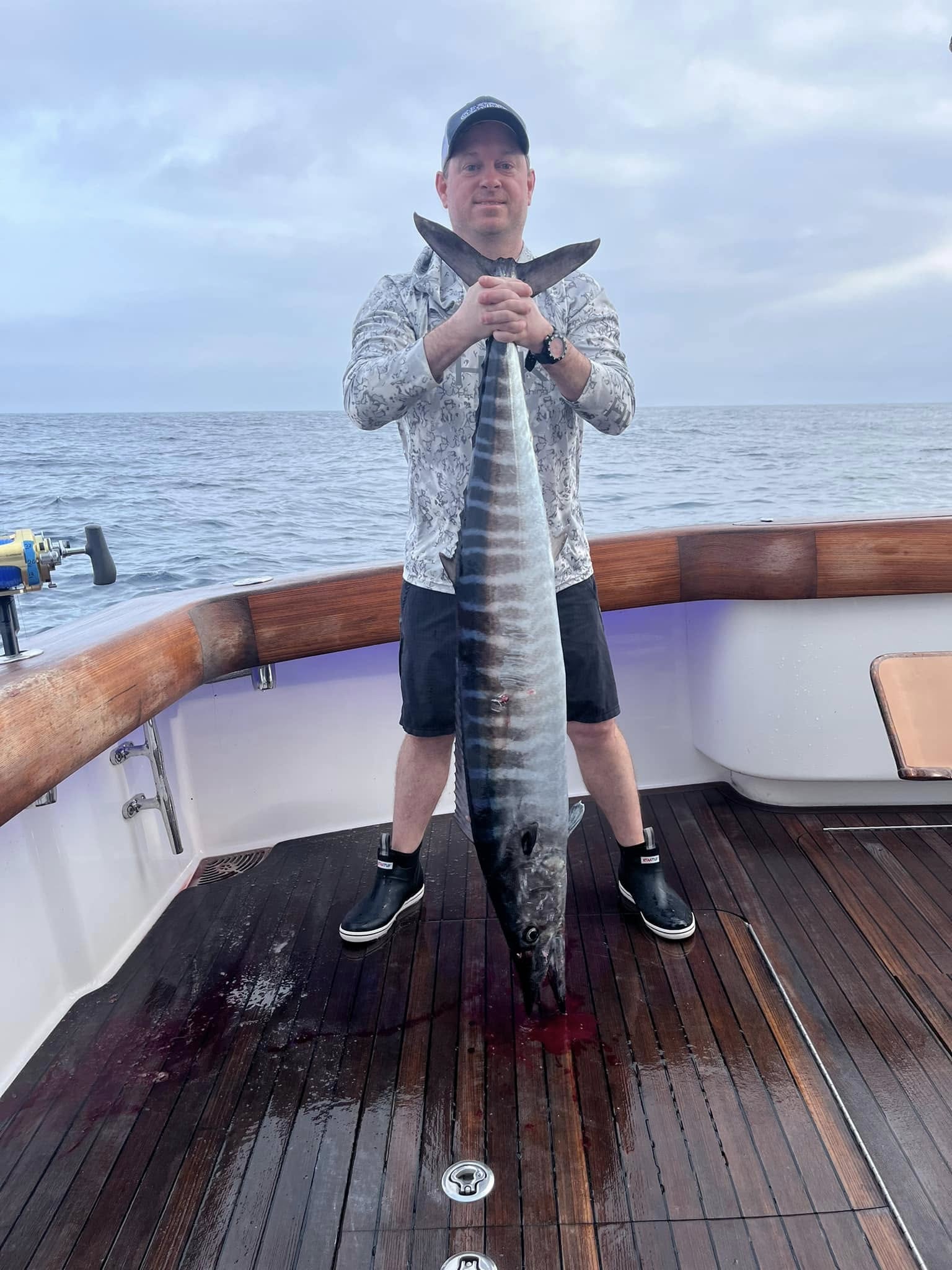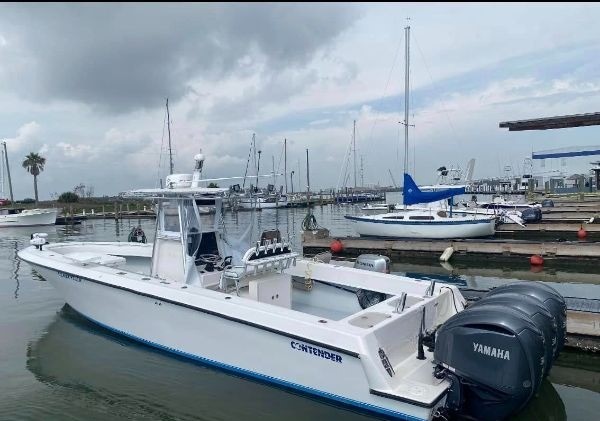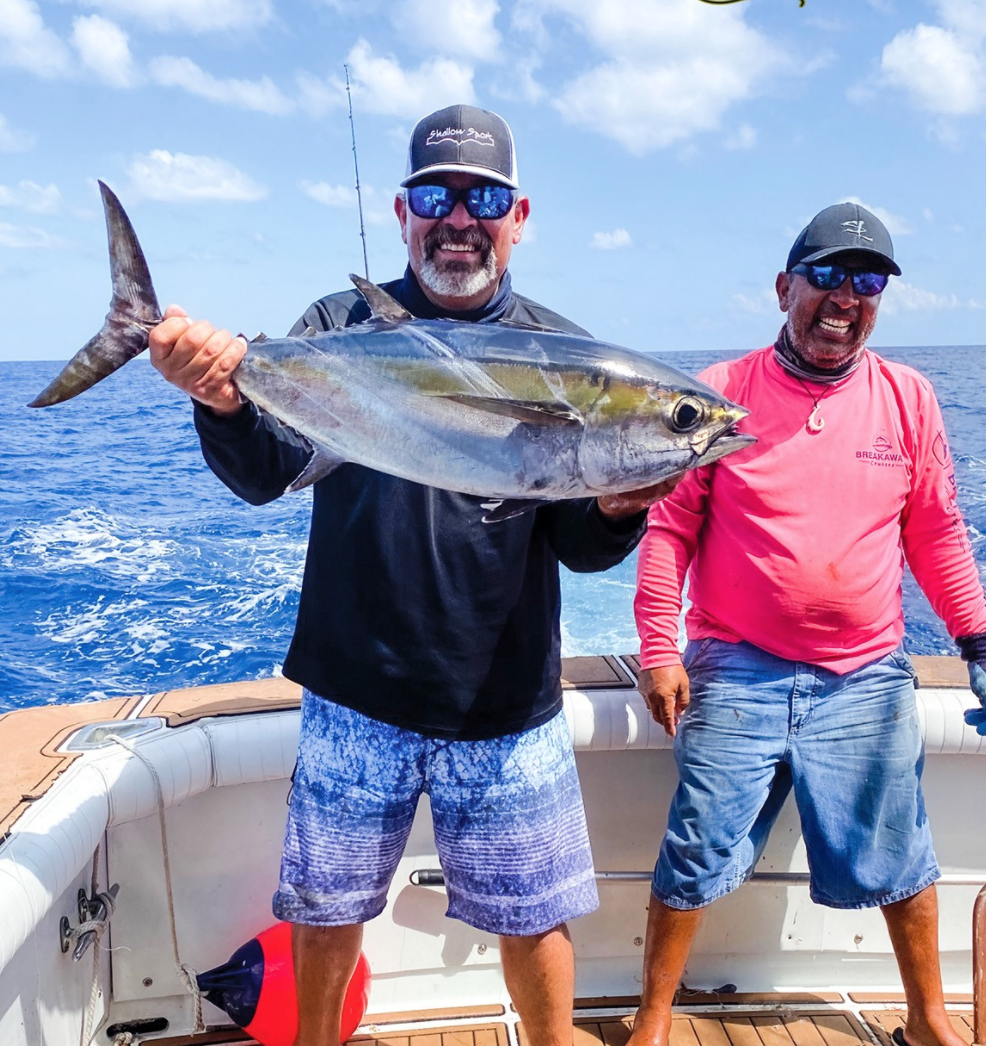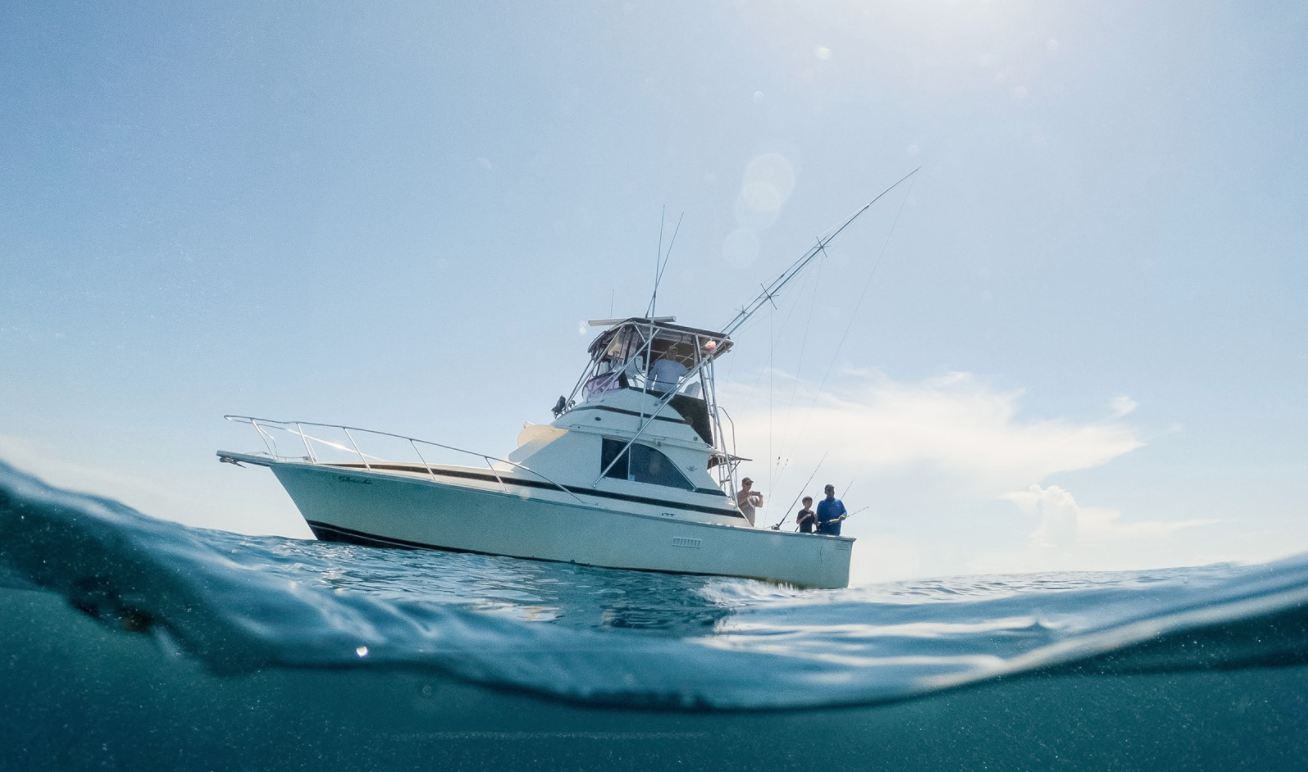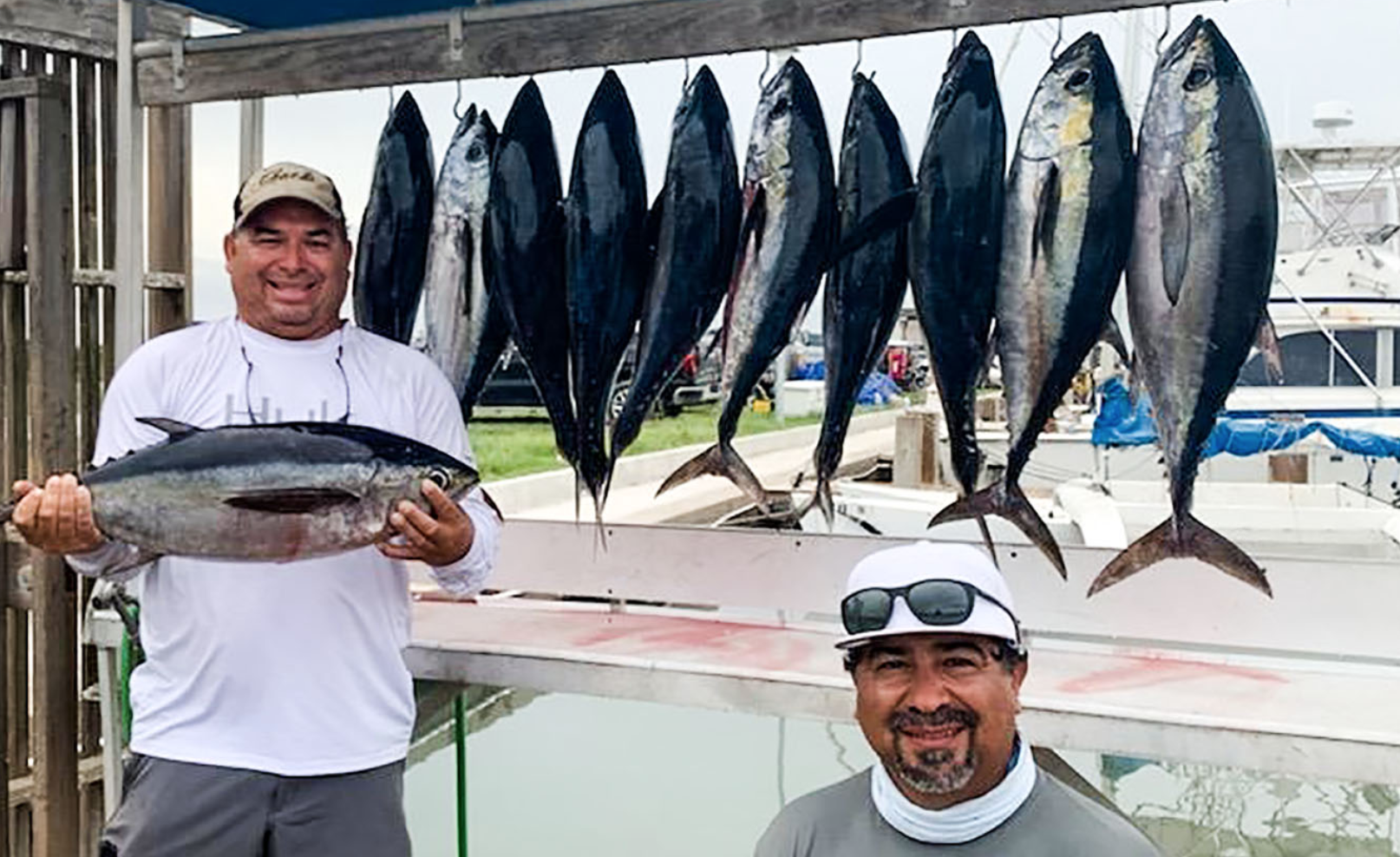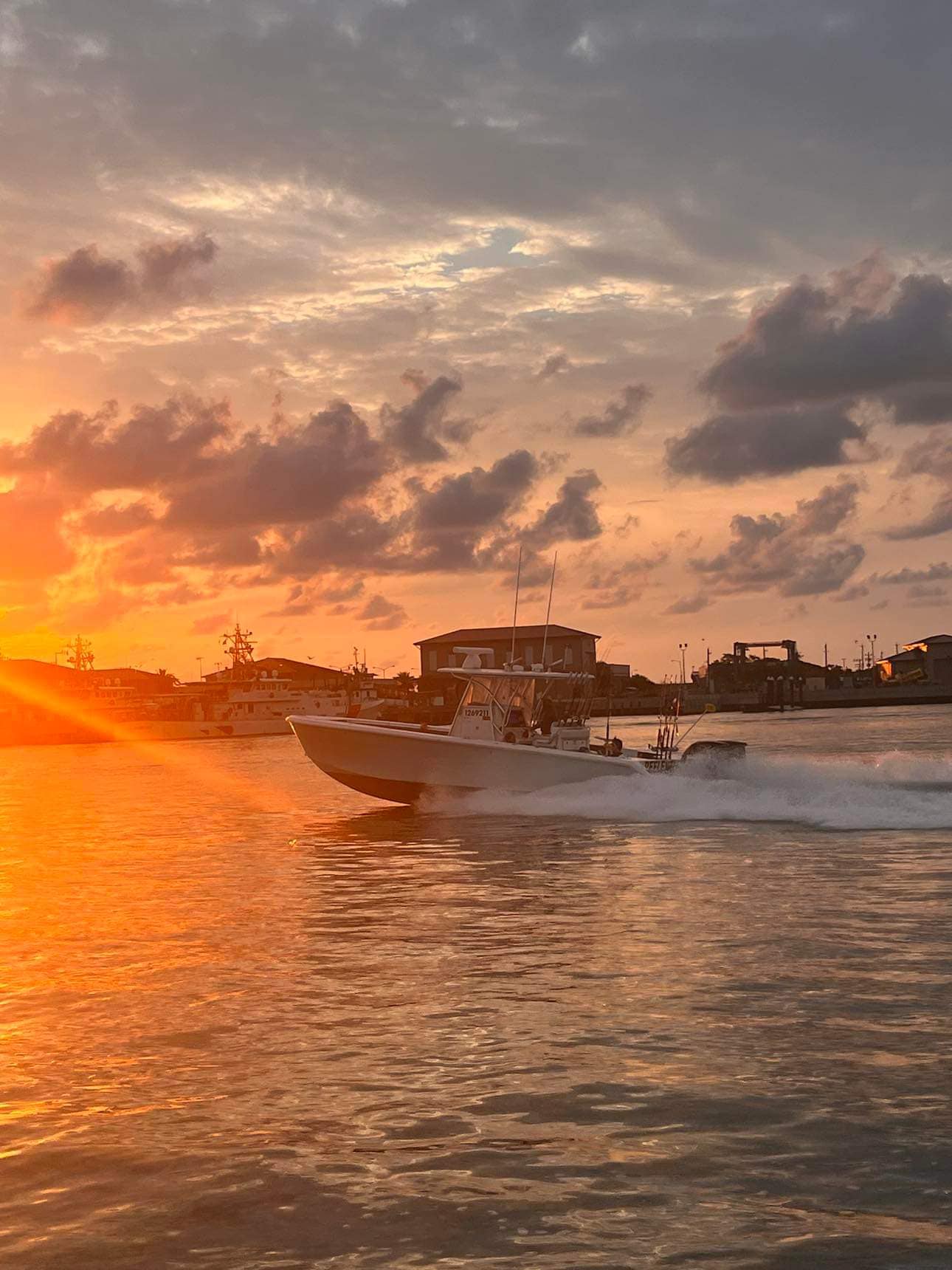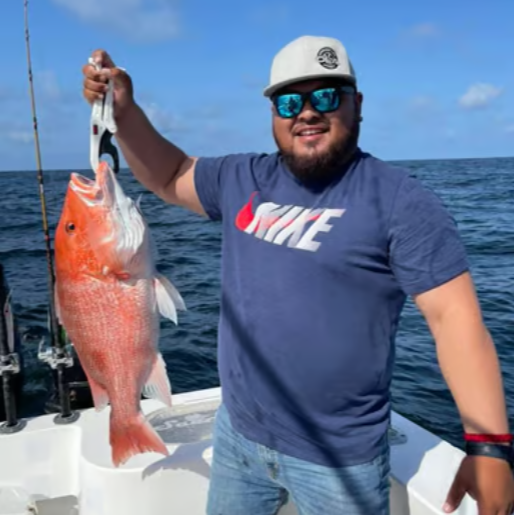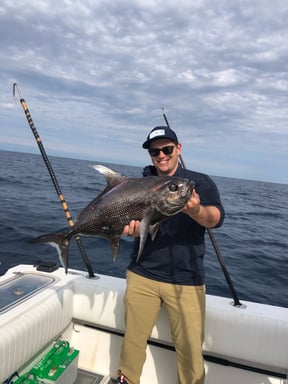48 Hr Deep Sea 55' Viking With Chef
48 Hour Deep Sea - 55' Viking
36 Hour Deep Sea - 55' Viking
36 HR Deep Sea 55' Viking W/ Chef
Galveston Deep Sea Trophy Fishing
12 Hour Galveston Deep Sea
12 Hour Deep Sea With Chef
12 Hour Trip – Blue Water Adventure
Deep Sea Fishing in South Padre Island
South Padre Island Deep Sea
Going Deep - 35' Sea Hunter
We started Captain Experiences to make it easy to book fishing and hunting guides around the world. With over 2,000 Damn Good Guides, our platform makes finding and booking a trip seamless. Head here to check out our trips.
The Galveston area provides a wide variety of wonderful saltwater fishing opportunities for anglers seeking both offshore and inshore fishing adventures. Anglers can catch all the major Gulf Coast saltwater species in the Galveston area. This includes inshore species such as speckled trout, redfish, flounder, black drum, and other species. Offshore species including red snapper, kingfish, ling (also known as cobia), and shark can be caught within ten to twenty miles from the Galveston beach, and further offshore you can catch tuna, mahi mahi, wahoo, sailfish and more. Anglers in Galveston are also known to catch some of the largest tarpon in Texas during the heat of summer and early fall.
Because the size of its fishable water and the size of its fish, Galveston is one of the most popular fishing destinations in the State of Texas. Galveston is located along the Upper Texas Coast, and it is approximately a one-hour drive south of the city of Houston, Texas. The name Galveston can refer to a lot of things: the city, the island, the county, and the bay system all share the name Galveston. Fortunately, all these places are in the same general geographic region, and you can simply refer to the whole area as Galveston.
Introduction To Fishing In Galveston
The Galveston Bay complex consists of four major bays including: East Galveston Bay (East Bay); Trinity Bay; Galveston Bay; and West Galveston Bay (West Bay). Trout, redfish, flounder, and other prized saltwater fish can be found in all four of bays in the Galveston area at any time of year. These bodies of water are so large that you cannot fish all the popular fishing locations that Galveston has to offer at the same time. Galveston just too much water to cover. Planning your Galveston adventure in advance will lead to better success in catching that fish of a lifetime on your next fishing excursion.
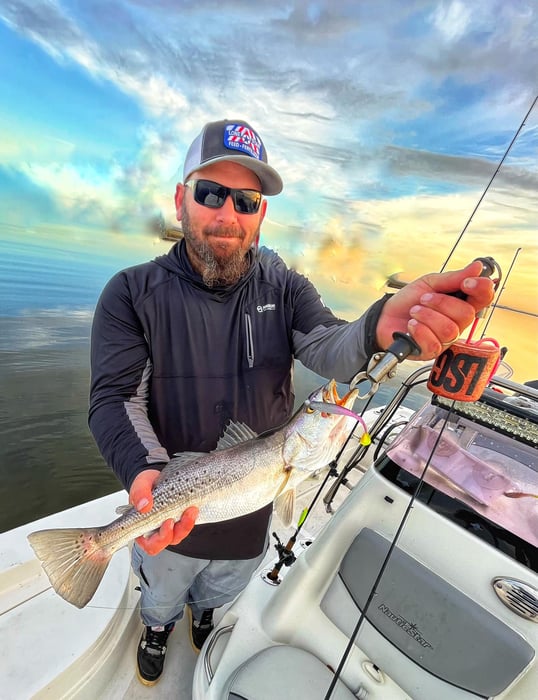
Galveston inshore fishing is focused primarily on speckled trout. The average sized speckled trout that you catch in Galveston just seems a bit larger than the average speckled trout from other areas. Redfish, flounder, black drum, and sheepshead are also key species for the Galveston Bay system. The Texas Parks and Wildlife Department recognizes these records for inshore species in Galveston:
Offshore fishing from Galveston offers the chance to catch even larger fish. From tuna to tarpon, Galveston’s offshore waters regularly produce fish weighing 20 to 200 pounds. Galveston’s offshore fishing offers anglers a chance to catch one of these sea monsters or perhaps some of the best tasting fish around such as red snapper, mahi mahi, or wahoo.
Kingfish are a great fighting fish, and these toothy speedsters patrol the waters just offshore Galveston in good numbers throughout the summer months. For long-range offshore fishing trips, Galveston is the nearest port to the famous Flower Garden Banks. The Flower Garden includes protected coral reefs so anchoring is not allowed, but the area surrounding the Flower Garden offers some unique deep sea fishing opportunities. Billfish, mahi mahi, and wahoo are generally caught many miles offshore from Galveston. Kingfish and red snapper, which are seasonal in Federal waters, can be caught less than 15 miles offshore.
Fishing Guides in Galveston
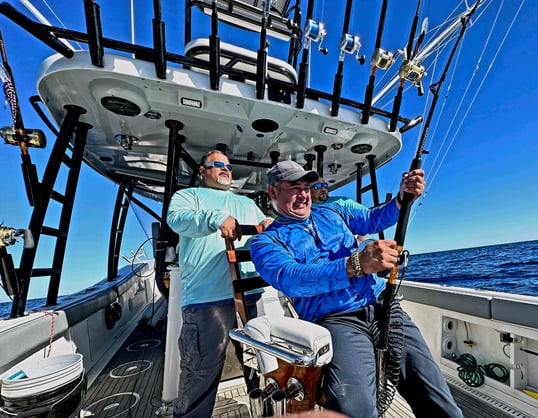
As one of the more popular destinations along the Gulf Coast, Galveston has many professional fishing guides available for charter for your next trip. You can book a Galveston fishing trip with both inshore and offshore guides who depart from multiple locations throughout the Galveston area. Captain Experiences offers a wide selection of professional fishing guide charters in Galveston including:
- Galveston Inshore Bay Fishing Guides
- Galveston Jetty Fishing Guides
- Galveston Offshore Fishing Guides
Captain Experiences also offers several specialty fishing guides based out of the Galveston area including:
- Galveston Flounder Fishing Guides
- Galveston Tarpon Guides
- Galveston Trophy Trout Guides
- Galveston Fly Fishing Guides
- Galveston Tarpon Guides
- Galveston Shark and Bull Redfish Guides
- Galveston Bowfishing Guides
- Galveston Luxury Deep Sea Fishing Guides
- Galveston Family Focused Fishing Guides
- Galveston for Beginners Fishing Guides
Whatever type of fishing you dream of doing on your next outdoors adventure, Captain Experiences wants to help you find a professional guide that can make your dreams come true. Professional fishing guides should be as excited as their customers about the opportunity to get outdoors and enjoy a wonderful day on the water. At Captain Experiences, we know that Galveston is a fantastic destination for both inshore and offshore fishing. For help booking a top-quality fishing guide in Galveston, visit us at captainexperiences.com.
Types of Fishing in Galveston
Galveston is located along the Texas Coast and borders the Gulf of Mexico. Galveston is an island, and the waters between the island and the mainland are bays that offer many inshore saltwater fishing opportunities. The body of water that borders the outside of Galveston Island away from the mainland is the Gulf of Mexico. The Gulf of Mexico provides anglers with many offshore saltwater fishing opportunities.
The first choice that anglers need to make when deciding to fish Galveston is which of the two general categories of fishing opportunities do you wish to pursue:
- Inshore fishing, also known as bay fishing, or
- Offshore fishing, also known as deep sea fishing.
Inshore Fishing in Galveston
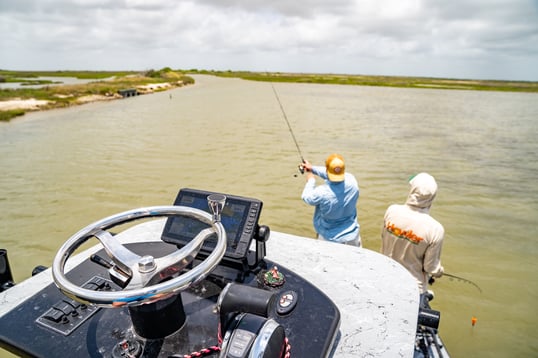
Inshore fishing, also known as bay fishing, in the Galveston area primarily focuses on the favorite inshore fish species that live in the Gulf of Mexico such as redfish, speckled trout, flounder, and black drum. Other fish species such as sheepshead, sand trout, gafftopsail catfish, and more are also regularly caught while inshore fishing in Galveston.
Inshore fishing in Galveston can include a variety of techniques including drifting, wading, anchoring, kayaking, and more. There are several fishing piers available for anglers in different areas of Galveston. Most of the inshore fish species that anglers target can be found around structure, near sandbars, along grass lines, or simply chasing schools of baitfish through open water. There is really no wrong way to fish for key species such as specks (speckled trout) and reds (redfish) because these fish can be found in a variety of different habitats and water depths.
The most popular methods of fishing for inshore species include using bait (live or dead) and fishing with lures. For bait, live shrimp is a favorite of almost any fish that you may encounter. Drifting or anchoring while using a live shrimp under a popping cork may be the single most popular fishing methods for anglers targeting speckled trout throughout the Galveston area. Other live bait options include using small croaker, mullet, pinfish, mud minnows and more. Dead shrimp is also a great option for the majority of inshore species including redfish and black drum.
Soft plastic baits that imitate a live shrimp or baitfish are the most popular lures for the Galveston area. These soft plastics come in a wide variety of shapes and colors. Other popular lures include top water baits, soft body lures such as Corkies, hard body lures, spoons, and more. When the weather is overcast and warm, speckled trout and redfish will explode on topwater lures in the shallow water. If you are lucky enough to be fishing when there is a good topwater bite, that will be some of the most memorable days you can have fishing the shallow waters around Galveston.
When it comes to inshore bay fishing, Galveston offers some outstanding opportunities for drifting or anchoring near oyster reefs and other structures that can hold the fish. Wade fishing along the shorelines, fishing from piers, and even kayak fishing are popular alternatives to drifting and anchoring from a boat. Redfish and speckled trout can be caught by lucky anglers in the Galveston area using any of these inshore fishing methods.
Offshore Fishing in Galveston
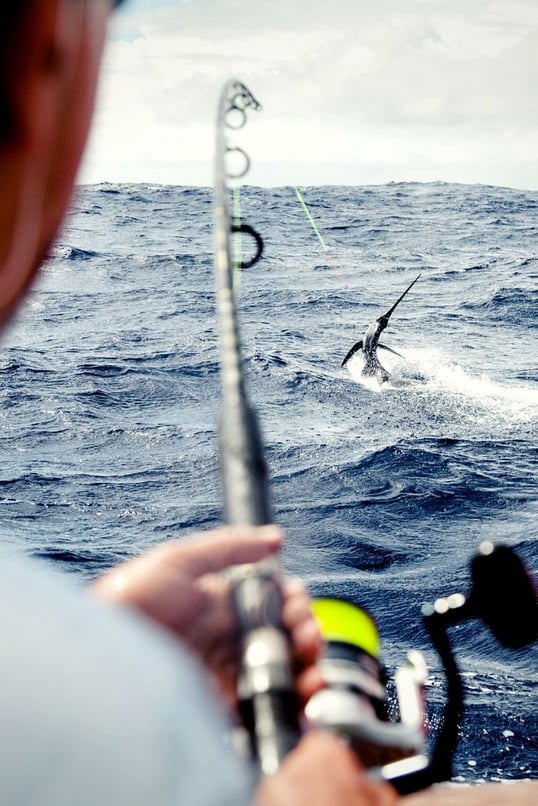
For offshore fishermen, Galveston offers access to many of the prized species found in the Gulf of Mexico. A few of the offshore species that can be caught outside of Galveston include:
- Red snapper
- Kingfish
- Cobia
- Shark
- Tuna
- Mahi Mahi
- Amberjack
- Wahoo
- Sailfish
- Marlin, and
- Tarpon
The water depth increases gradually as you travel away from Galveston into the Gulf of Mexico. Many of these popular offshore species prefer different water depths and temperatures, and these preferences will dictate how far offshore you must travel in order to increase your chances of catching your prized fish.
Tarpon and some sharks can be caught within a few miles of Galveston’s popular beaches. Kingfish are generally a little further offshore, but during the calmest days of summer even kingfish can follow the bait and blue water closer to shore. Red snapper and the occasional cobia can be caught a dozen or so miles from Galveston Island during certain times of year, but these species are also caught much further offshore. Tuna, mahi mahi, amberjack, wahoo, sailfish, and marlin generally preferred the deeper waters, and these sportfish are encountered many miles offshore from Galveston.
When offshore fishing from the Galveston area, the choices you make regarding how you fish will play a big factor in which type of fish you catch. Kingfish are frequently caught while trolling or drifting baits below the surface of the water. Red snapper are caught at or near the bottom of the sea floor hanging around a variety of structures such as offshore reefs and rigs.
Tarpon often hit a live bait, and sharks are more frequently caught using some type of dead bait. If you are new to offshore fishing, it is certainly best to learn from experienced fishermen so that your fishing technique will be appropriate for the type of fish you hope to catch.
Charter Fishing in Galveston
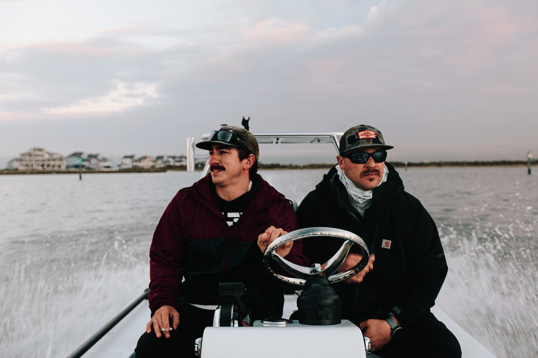
If you decide to book a charter fishing trip in Galveston, one of the first things that you will notice is that there are a lot of options. Because it is such a popular angling and beach tourist destinations, Galveston has many professional fishing guides that cater to a variety of anglers. Some of the things that you will need to consider when hiring a professional fishing guide include: how many people are in my group, how long do we intend to fish, what type of fish am I hoping to catch, what is my price range for a fishing charter, and where will I be staying while visiting Galveston.
Captain Experiences knows that booking a fishing charter for a vast body of water such as the Galveston area is complex, and we have experts that can help guide you to the right choice when you are ready to book a fishing trip. You can find several tips for booking a fishing charter and a selection of highly-rated Galveston fishing guides at CaptainExpereinces.com.
Most private inshore fishing charters are allowed to take groups up to 6 people on a day of fishing, but groups of 3 to 4 people are much more common. The inshore fishing boats are typically in the 19 to 26 foot range, and this size boat usually provides enough room for up to 4 people to comfortably fish at the same time. Larger offshore boats can sometimes take larger fishing parties. Always check with your fishing guide to understand how many people can go on a charter trip. Also, Galveston has a few non-private party boats that can take dozens of fishermen from multiple different fishing groups.
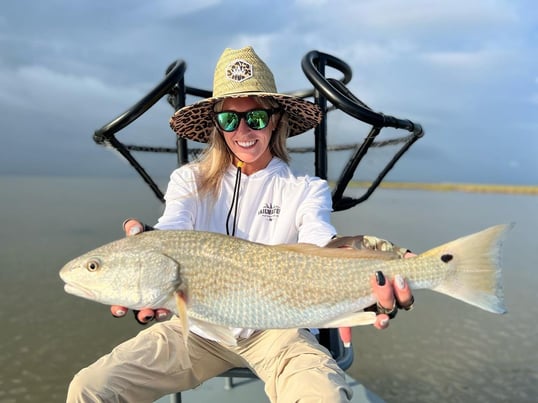
Some private charters give fishermen the option between choosing a half-day trip or a full-day trip. A half-day is usually around 4 hours, and a full day of fishing is usually about an 8 hour adventure. Inshore fishing and jetty fishing can be quite productive on a half-day trip. For deep sea fishing charters, additional hours are needed because there is travel time in getting to the most productive fishing waters.
When planning a charter fishing trip in Galveston, you need to know that different private charter guides specialize in catching different species of fish. Many inshore guides will fish for several species such as speckled trout, redfish, flounder, and black drum. However, there are several Galveston area guides that focus on a type of fish such as seasonal Tarpon, bull redfish, sharks, or red snapper. The longest deep sea fishing charters will usually target multiple offshore species of fish on a single trip.
Pricing for private fishing charters varies. A half-day inshore fishing charter for Galveston may be a few hundred dollars, and a full day on a luxury deep sea fishing vessel will obviously cost more. Captain Experiences offers clear pricing at all levels for anglers who are seeking a guided fishing trip in the Galveston area.
Where you stay in Galveston can also make a difference in which fishing guide would be best for next Galveston charter. The majority of Galveston bay fishing charters leave from somewhere on Galveston Island, but there are multiple marinas and boat ramps preferred by fishing guides. Some fishing guides that fish the Galveston area are not located on Galveston Island. There are many marinas and boat ramps on the mainland that offer access to fishing in the Galveston area. Make sure you understand where your guide like to meet up with anglers before you book your trip.
Whether you are looking for a trip for your family or a large group, Captain Experiences would be thrilled to help you navigate the waters of selecting the best Galveston fishing guide.
Kayak Fishing Near Galveston
If you are looking to kayak fish while you are visiting Galveston, that is also an option. There are several kayak access points available in Galveston. The shorelines of West Bay, East Bay, and Trinity Bay offer some excellent opportunities for kayak fishermen to hook into a speckled trout or redfish. Captain Experiences can assist you in finding a kayak fishing guide in Galveston if you do not already have all of your own kayak fishing gear. Kayaking is growing trend amongst anglers, and kayaks are a great way to enjoy the beauty of the outdoors.
Fly Fishing from a Skiff
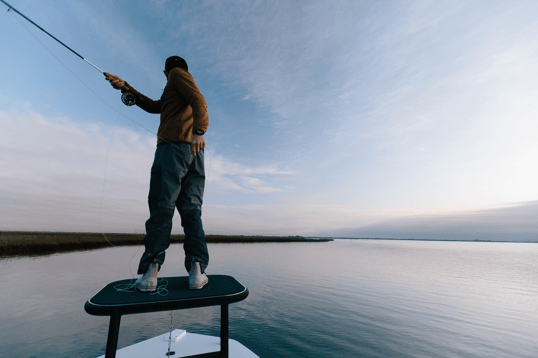
Fly fishing is at its best when you can get into the skinny water of a back lake or the flats with a smaller, lightweight boat such as a skiff. Galveston is not a classic fly fishing destination, but that does not mean that there are not any fly fishing opportunities. Most of the Galveston Bay complex is a few feet deep, so fly fishermen typically focus on the shallow edges of coves, marshes, and a handful of small back lakes. Redfish are the key species for Galveston fly fishermen. Spotting a large redfish cruising the shallow grass flats before sight casting is a once in a lifetime experience for many anglers.
Flounder Gigging after Dark
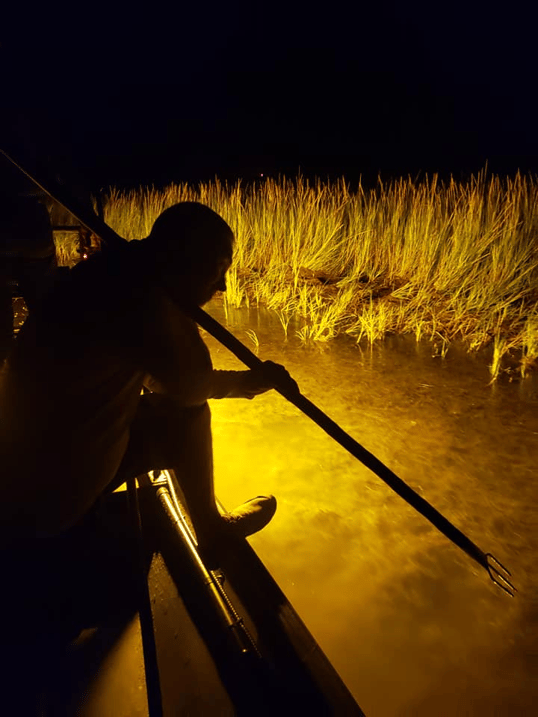
If your days in Galveston are too busy for fishing, then you may still be in luck. Flounder gigging is a nighttime activity in which you ride at the front of a flat bottom boat with special lights designed to shine into the water. This is a unique fishing adventure that most anglers never get the opportunity to enjoy.
Jetty Fishing in Galveston
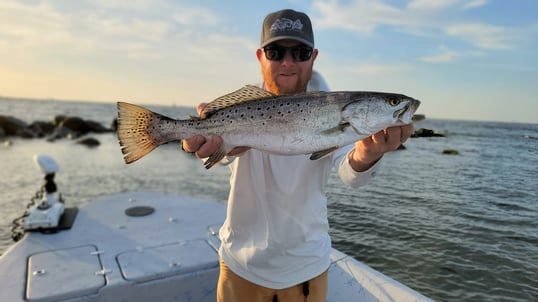
Galveston has two excellent jetties that offer excellent fishing opportunities. The jetties are the sets of rocks that extend from the tip of the island into the Gulf of Mexico. There is one jetty on Galveston Island and a second jetty across the channel on the Bolivar Peninsula. Fishing the jetties is popular at all times of the year, and many of the inshore bay fishing guides take their anglers out to the jetties.
Nearshore Fishing in Galveston
When you are researching fishing excursions for the Galveston area, you might come across the term nearshore fishing. Nearshore is basically the first few miles of water past the jetties and beaches. Species such as tarpon, sharks, bull reds, and sometimes kingfish could be the target saltwater fish species in Galveston’s nearshore waters depending on the time of year. Be sure to check with your fishing guide to understand what is expected when booking a nearshore fishing trip.
Surf Fishing in Galveston
With miles and miles of beaches, Galveston offers anglers the opportunity to surf fish for redfish, speckled trout, whiting, sharks, jack crevalle, croaker, or any other species that might be swimming in the waves. When the summer seas are calm and water runs a clear blue-green color all the way to the beach, that is your best chance of catching speckled trout in the surf. Caution is needed when wade fishing the surf because of the potential for undertow and moving sandbars, so make sure to use a life jacket and obey any warnings.
Pier Fishing in Galveston
Galveston has a number of public fishing piers that attract anglers throughout the year. Some of the most popular fishing piers are large structures that extend right out from the beach into the Gulf of Mexico. When the bull reds are running in the surf, these piers can get exciting. The Galveston Fishing Pier and the 61st Street Fishing Pier are two large and popular surf fishing piers. Other piers offer access to different parts of the Galveston Bay complex including piers at Seawolf Park near Galveston and in the San Leon area if you are on the mainland near Clear Lake.
Best Lures and Best Baits for Fishing Galveston
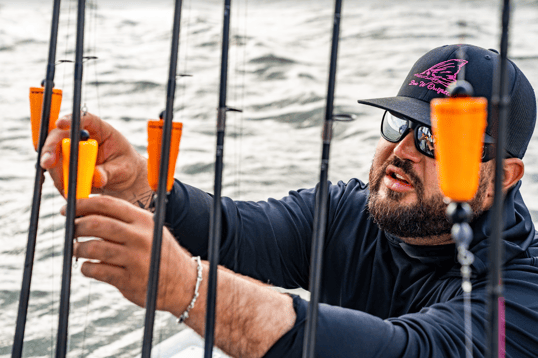
The best baits and lures to use in the Galveston area will depend on what type of fish you are trying to catch. As you would expect, the baits and lures for offshore fishing and inshore fishing are different. Here is a quick overview of some of the more popular lures and baits for fishing Galveston.
Live shrimp are one of the most effective baits for catching a variety of inshore species. Live shrimp are generally fished in three different ways: under a popping cork or similar float; with a weight to get the shrimp near the bottom; or free shrimped with just a hook and no weight or bobber. All the popular inshore species will eat live shrimp: redfish, speckled trout, black drum, sheepshead, flounder, and more are big fans of live shrimp.
You can purchase live shrimp from one of the many bait shops in the Galveston area, and you will need some type of bait bucket and possibly an aeriation device to keep the shrimp alive. Live croaker and mullet are also popular redfish and speckled trout baits, and live mud minnows are a great bait for flounder. If you book a private fishing charter, your professional fishing guide should provide all the bait and lures that you will need while fishing.
If you cannot get live bait, fresh dead shrimp or locally caught frozen shrimp is a good option. Frozen imported shrimp or farm-raised shrimp can carry diseases that threaten the local shrimp populations. Speckled trout typically prefer live bait, but redfish, black drum, and other common inshore species are happy to eat shrimp in any condition. Offshore baits for bottom fishing include squid and a variety of small bait fish. Offshore baits for trolling typically include ribbonfish, cigar minnows, and more. The bait for offshore fishing is usually sold frozen at the local bait shops.
One of the exciting aspects of using lures to catch reds and trout is that you never know what lures will be the best. Trout and redfish are like largemouth bass in that they will eat a wide variety of lures. Top waters, soft plastics, hard body lures, saltwater flies, spoons, and soft body lures can all entice a strike from a large speckled trout or an upper slot redfish. There are a few lures that might favor one species over the other, but those lures are the exception.
Species of Fish in Galveston
The main fish species targeted by Galveston anglers include speckled trout, redfish, flounder, black drum, sheepshead, gafftopsail catfish, jack crevalle, Spanish mackerel, sand trout, and more. The two prized game fish that stand out from the rest of Galveston species are redfish and speckled trout. Other fish such as flounder and black drum are regularly targeted in Galveston as well, but speckled trout and redfish are more the consistently sought after and caught by both fishing guides and recreational anglers.
The offshore fish in the Galveston area include the species that you would regularly find in the Gulf of Mexico. These fish include red snapper, kingfish, cobia, shark, tuna, mahi mahi, amberjack, wahoo, sailfish, marlin, and tarpon. Some of these fish such as tarpon and sharks can roam surprisingly close to Galveston Island. Kingfish and red snapper are further offshore. Cobia, tuna, mahi mahi, amberjack, wahoo, and billfish typically prefer deeper waters that many miles from the Galveston coastline.
Speckled Trout Fishing in Galveston
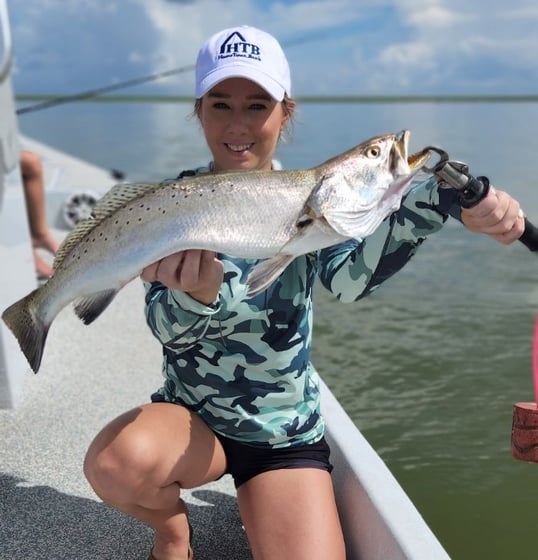
Speckled trout are the number one type of fish that inshore anglers pursue throughout the Galveston Bay system. Trout can be caught in many fishing environments: jetties, saltwater lakes, reefs, shorelines, flats, passes, surf, channels, and just about anywhere else you choose to fish in the inshore saltwater areas around Galveston can hold speckled trout in good numbers. Live shrimp are the number one bait, and soft plastic shrimp imitations attached to a jig head are the main lure of choice for anglers throwing artificial lures in Galveston. There are so many ways to catch speckled trout in Galveston, that we just can’t list all the ways.
A big trout over 25 inches long is truly a trophy. Those who target large speckled trout know that these fish can be few and far between. However, Galveston is a great location to pursue large trout as well as the more common keeper sized fish.
The legal size limit and daily bag limit for keeping speckled trout to eat is set annually by the Texas Parks and Wildlife Department. The limit on all fish do change from time to time, so make sure you check for the latest information. The 2023 limit for speckled trout in Galveston is 5 fish per day between 15 and 25 inches. Anglers can retain one speckled trout over 25 inches per day, and this fish does count towards the daily bag limit. Anglers who follow good conservation practices help keep the fish populations healthy for their next fishing adventure.
Redfish Fishing in Galveston
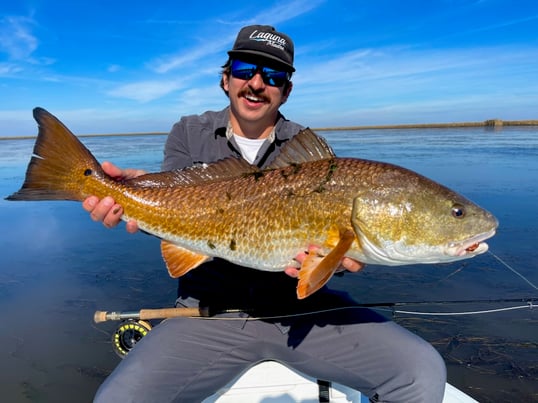
Redfish are one of the hardest fighting fish that you can catch while inshore fishing. Chances are that if you caught both redfish and trout during a day of fishing, your average redfish pulled a lot harder than your average speckled trout. This is no surprise as redfish tend to be a bit bigger. The 2023 slot size limit for redfish is 20 inches to 28 inches in Texas.
Redfish are often caught in the shallower, more marshy areas of the Galveston Bay complex. But redfish are equally at home along any Galveston shoreline, reef, or similar structure. Redfish can be caught in the same ways as speckled trout, but redfish generally prefer a bait closer to the bottom. If you are primarily targeting redfish using bait, then you will likely be better off using a weight than a cork when fishing the relatively deep waters of Galveston Bay.
Redfish will eat live bait, dead bait, and a variety of lures. With redfish, anglers often just cast out their bait to a promising looking and wait for the bite. Soft plastics and spoons are good lure choices when fishing for reds with artificial lures.
Flounder
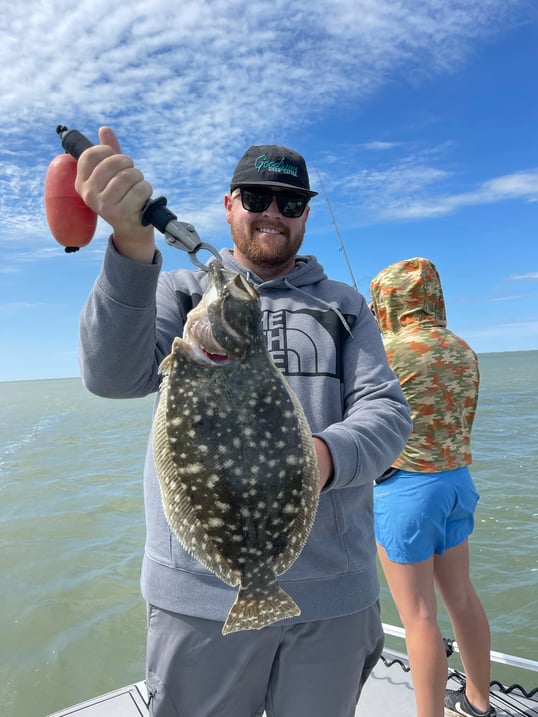
Flounder are a prized fish because many anglers consider these flat fish to be the tastiest table fare of the inshore species. Flounder live on the bottom of the bay floor and frequently bury themselves in the sand or mud to help camouflage their next attack on an unsuspecting bait fish. Flounder like to hang around drains, grass points, and channels where they can easily access their prey.
Galveston is a great place to fish for flounder. Flounder typically migrate from the marshes in the fall to the Gulf of Mexico. Flounder repeat this pattern in the spring. Texas has closed the flounder season during parts of the fall migration in recent years, so make sure you abide by the changing rules and regulations. Seawolf Park has historically been one of the best locations to target flounder moving between Galveston Bay and the Gulf of Mexico.
Black Drum
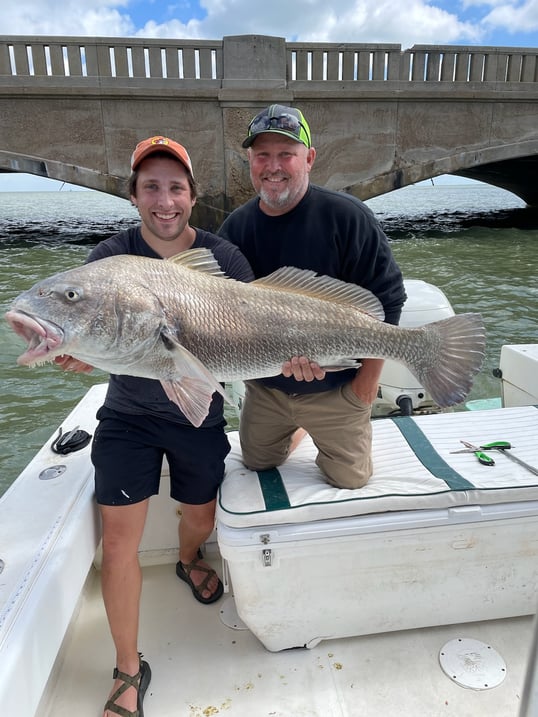
Black drum are related to red drum, which are better known as the popular redfish that we all love to catch. Black drum are hard fighting fish that primarily feeds along the bottom of the bay and along the Galveston jetties. Black drum, often referred to simply as drum, are a delicious fish to eat if you catch one that is not too big.
Sheepshead
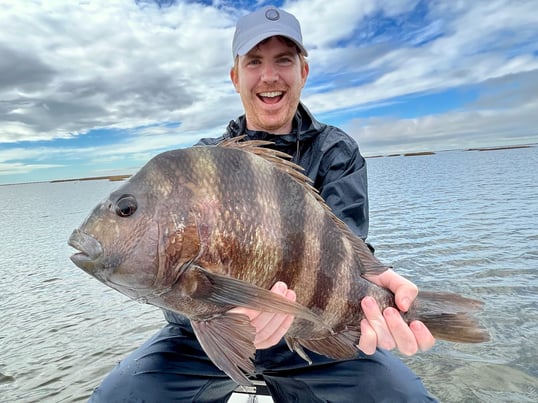
Sheepshead are a toothy fish that many anglers love to target along the Galveston jetties and other structures. Certain times of year tend to be better for catching large numbers of sheepshead as they congregate along the jetties and similar formations.
Red Snapper
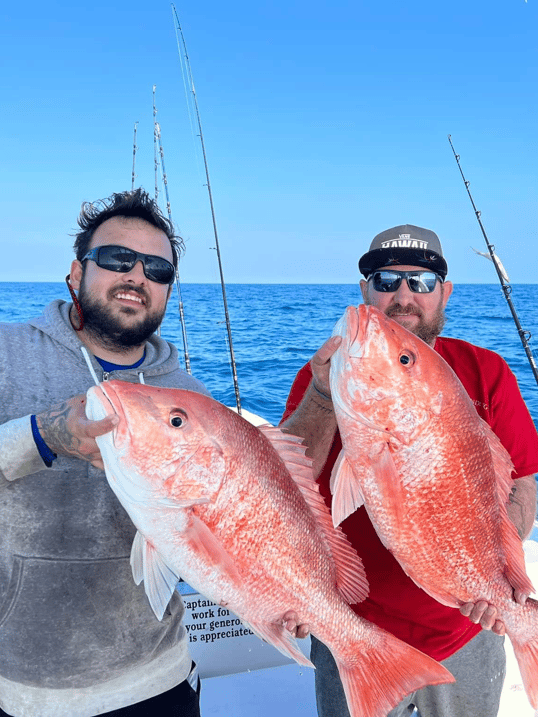
Red snapper are caught on deep water structures offshore from Galveston Island. There are different state and federal regulations related to keeping red snapper, so anglers will need to be apprised of all the rules before putting any red snapper in the cooler. Red snapper are classically caught by dropping a heavily weighted line down towards a reef, rig, or shipwreck. It is hard to go wrong with squid when fishing for snapper. Red snapper are strongly desired as one of the best tasting fish found anywhere.
Kingfish

Kingfish are an excellent sport fish. Galveston kingfish can get large, and it is always exciting to see the line burning away from the reel when a kingfish starts to run. Use care when catching kingfish because these fish are mighty toothy.
Shark
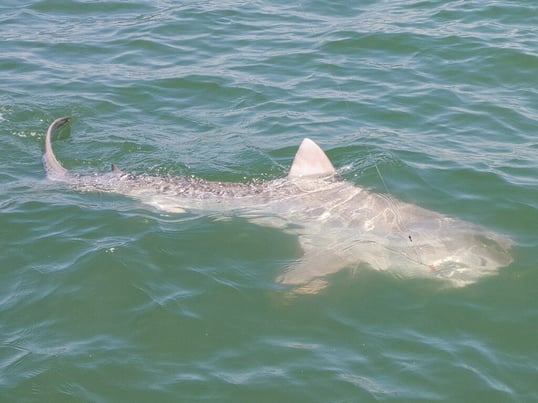
Shark can be caught both nearshore and offshore in the Galveston area. Shark are regularly caught by anglers while pursuing other species, so you can easily end up catching a shark when that fish is not your main target species. For those anglers who target large sharks, Galveston is a great place to try your luck at catching the next Jaws.
Tuna
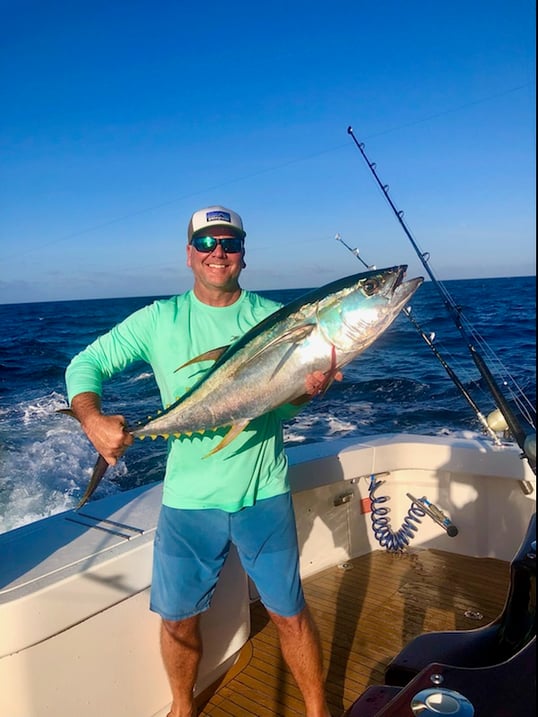
Blackfin tuna are the predominant species in the Galveston offshore water, but yellowfin tuna are also caught. Tuna put up a great fight, and it is truly a special treat to dine on fresh tuna.
Jack Crevalle
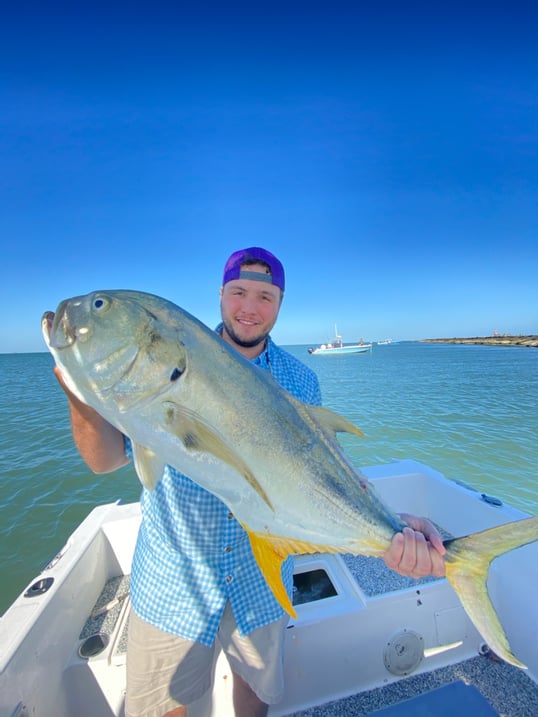
Jack crevalle, also known as jackfish, are one of the hardest fighting fish around. Jackfish are a wide-roaming species that can be caught inshore, nearshore, and offshore. If you are interested in catching big fish just for the sport of it, this is the fish for you.
Amberjack

Amberjack are the tasty cousin of jack crevalle. Galveston’s amberjacks are found many miles offshore, so these species are best targeted during a long offshore charter.
Mahi Mahi
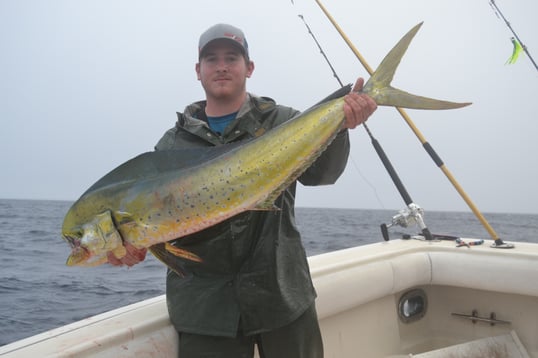
Mahi mahi or dolphin are exciting fighters and wonderful fish to eat. In addition, mahi mahi are one of the prettiest fish that you will ever see. The beautiful colors fade quickly, but the memories of catching mahi mahi can last a lifetime. One of the longer offshore charters is recommended to target mahi mahi in the Galveston area.
Tarpon
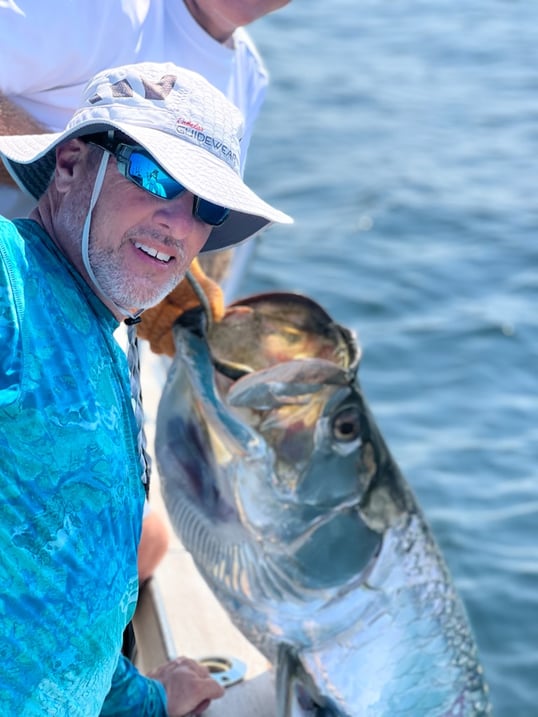
Known as the Silver King, tarpon are another unique species that many anglers put on their bucket list. Tarpon regularly weigh 70 pounds and more, and Galveston has some of the largest Tarpon on the Texas coast. Tarpon make spectacular leaps through the air in their all too often successful attempts to shake the hook out. Galveston is a legitimate destination for tarpon during the late summer and early fall months.
Wahoo
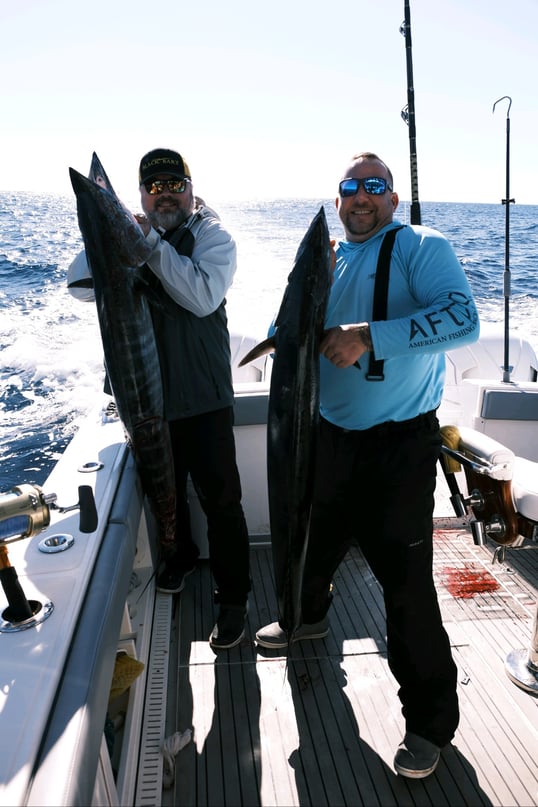
Some of the largest wahoo around have been caught far offshore from Galveston. Wahoo are known for being extremely fast, and these fish can get quite large as well. Wahoo live in deeper waters, so just getting out to the parts of the Gulf of Mexico that holds wahoo can be an adventure. Wahoo are also one of the best tasting offshore fish available.
Marlin
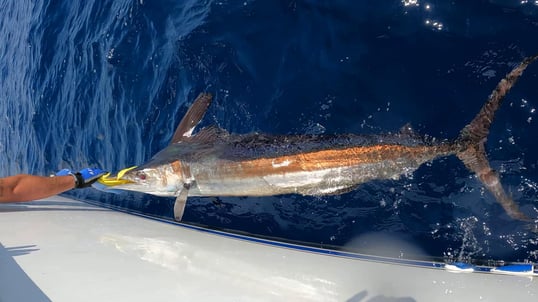
Marlin are a classic big game fish. Blue marlin are the largest billfish regularly caught in the Galveston area and throughout the Gulf of Mexico. Billfish of all species are found in deeper waters, and a longer offshore charter is recommended if you are seeking this type of fish from the Galveston area.
Sailfish
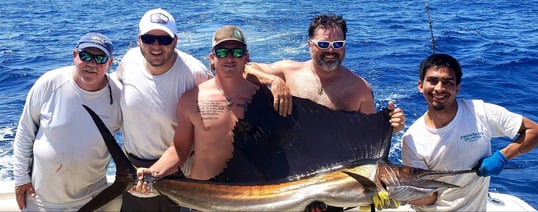
Another billfish, the sailfish are likely the most commonly caught billfish species in the Gulf of Mexico. Sailfish can make great jumps and put up a great fight for the anglers lucky enough to hook into one of these fish. Sailfish are also a longer offshore journey for anglers leaving from Galveston.
Popular Fishing Spots in Galveston
As the major fishing destination along the Upper Texas Coast, Galveston has many famous and popular fishing spots. Of course, your own secret fishing hole near Galveston is probably the best one.
List of Fishing Spots Near Galveston
Some of the main areas that you may be fishing when visiting Galveston include:
- Bolivar Peninsula
- Anahuac Wildlife Refuge
- East Bay Shorelines
- Hannah's Reef
- Anahuac Pocket
- Smith Point
- Old HL&P Spillway
- North Jetties
- South Jetties
- Texas City Dike
- Pelican Island / Seawolf Park
- Ship Channel Spoils, Reefs, and Wells
- Galveston Surf
- West Bay Shorelines
- Chocolate Bayou
- Greens Cut and Greens Lake
- Confederate Reef and Carancahua Reef
- San Luis Pass
- Christmas Bay
- Galveston Offshore Rig Fishing
- Galveston Offshore Shrimp Boat Fishing
- Galveston Flower Garden Banks and Far Offshore Water
Bolivar Peninsula, Anahuac Wildlife Refuge, East Bay Shorelines
The Bolivar Peninsula, Anahuac Wildlife Refuge, and the East Bay shorelines are located in East Galveston Bay. There is a ferry that crosses from Galveston Island to the Bolivar Peninsula to provide access to East Bay. The Bolivar Peninsula offers surf fishing along the south side, and bay fishing on the north side of the peninsula.
The Anahuac National Wildlife Refuge surrounds the northeast side of East Galveston Bay. The wildlife refuge provides excellent wildlife viewing opportunities if you want to see a lot of alligators plus some great fishing. Drift fishing while looking for birds and slicks in East Galveston Bay near the Anahuac National Wildlife Refuge can be an exciting way of catching speckled trout and other species.
The shorelines of East Galveston Bay hold good numbers of redfish, speckled trout, and flounder. Anglers will need a professional fishing guide or their own boat to access most of East Bay because the large stretch of shoreline on the north side of the bay is mostly private property. On the south side of East Bay, fishermen will need a boat to cross the intercoastal waterway to reach some of the best shoreline fishing in the Galveston area. The East Bay shorelines include spots like the Pig Pen, Fat Rat Pass, and Pepper Point that attract the fish and the fishermen.
Hanna’s Reef
Hanna’s Reef, Lil Hanna’s, Deep Reef, and other reefs in East Galveston Bay are excellent locations for drift fishing and anchoring for a mixed bag of both speckled trout and redfish. With commercial oyster fishing and hurricanes over the past several years, the best sections of reefs to fish have changed a bit. Knowledgeable guides and locals can find the best areas that still have a good oyster reef bottom. The changing depths of the oyster reefs and variability in structure can also make navigation a bit tricky, but these changes are the same thing that attract fish to Hanna’s reef and other nearby reefs in East Galveston Bay.
Anahuac Pocket, Smith Point, and Old HL&P Spillway
Trinity Bay is the northern portion of the Galveston Bay complex where the Trinity River dumps into the marsh. The upper portion of Trinity Bay contains the Anahuac Pocket and the HL&P Pocket that offer excellent fishing for schools of speckled trout and redfish during the late summer and early fall months. When the first few cold fronts arrive for the year, the pockets of upper Trinity Bay offer anglers protection against the wind and also encourage the shrimp to migrate out of the marsh for the winter. The hungry predator fish anticipate this shrimp migration every year. These upper pocket areas and the open waters of Trinity Bay are frequently the best places to drift fish under feeding birds in the Galveston Bay complex.
Smith Point is the large point of land that separates East Galveston Bay and Trinity Bay. The Smith Point area contains a few islands, shorelines that offer protection from the wind, and several nearby reefs. Smith Point is long way from the cities of Galveston and Houston by road, but the point sticks so far out into Galveston Bay that it is accessible from many boat ramps in Galveston Bay, Trinity Bay, and East Bay.
The northern shoreline of Trinity Bay has a famous fishing hole where the old HL&P company private lake has a spillway that dumps into the side of the bay. This spillway has always been a magnet for all types of fish including giant speckled trout, redfish, and flounder. Fishing the HL&P spillway on the right day can be one of the best places to fish along the Texas coast.
North Jetties and South Jetties
Galveston has two great jetties that provide year-round opportunities for catching many different species of fish. The North Galveston Jetty is located on the south end of the Bolivar Peninsula. The South Galveston Jetty is located on the north end of Galveston Island. A channel that connects the ports of Galveston and Houston with the Gulf of Mexico runs between the Galveston jetties.
Fishing the Galveston jetties offers opportunities for all anglers to catch several species of fish using a variety of different methods. Some species, such as redfish and black drum, tend to stack up along the base of the jetties. Dead shrimp and a heavy weight are a popular rig for catching these fish along the Galveston jetties.
Speckled trout seem to gather closer to the water surface. Using a popping cork or free lining live bait is often a good technique for catching trout along the Galveston jetties. Many other species of fish can be caught at the Galveston jetties including sharks, sheepshead, and bull reds. Half the fun of fishing the jetties is that you never know what you might catch on any given cast.
Species of Fish at the Galveston Jetties
Many types of fish spend some time at the Galveston jetties throughout the year. Some of the more popular species that you can catch at the Galveston jetties include:
-
Redfish: Bull reds migrate through the jetties to the Gulf of Mexico, and redfish of all sizes roam the jetties in search of meal.
-
Speckled Trout: Specks can be caught at the Galveston jetties nearly year-round, and taking advantage of the higher numbers of speckled trout during the spring and fall migrations can pay off for anglers.
-
Sheepshead: Sheepshead put up a good fight and make good table fare. Sheepshead are attracted to structures like the Galveston jetties.
-
Black Drum: Black drum can stack up along the Galveston jetties in good numbers at certain times of the year.
-
Jack Crevalle: Jacks are a hard-fighting fish that is just as likely to break your line as it is to be reeled in back to the boat. Hooking a jack at the Galveston jetties is an experience that you will not soon forget.
-
Sand Trout: Sand trout, or sandies, are another species that can be caught while fishing the Galveston jetties. Although smaller than speckled trout, sand trout can be present in large numbers and make for some fast-fishing action.
-
Flounder: Flounder migrate to the Gulf of Mexico each fall. Many of these flat fish pass through the Galveston jetties.
-
Tarpon: Although most Texas Tarpon in the Galveston area tend to show up a few miles past the jetties, some Tarpon are caught by anglers fishing the Galveston jetties.
-
Spanish Mackerel: During warmer months, schools of Spanish mackerel can be found near the Galveston jetties.
-
Shark: Some surprisingly large sharks are caught near the Galveston jetties. You need the right fishing gear to land one of the big sharks.
Texas City Dike
The Texas City Dike has been called the world’s largest man-made fishing pier. The Texas City Dike has boat ramps, piers, and miles of fishing opportunities along its sides. Black drum are one of the best species to target from the dike, and bull reds are common as well. The waters immediately surrounding the dike can be great for catching speckled trout, flounder, and redfish. The north side of the Texas City Dike has some flats that can be waded or fished from a kayak. The southern facing side of the Texas City Dike has a deeper drop-off. There are rocks along the edges of the Texas City Dike, and these structures make great habitat for gamefish throughout the year.
Pelican Island / Seawolf Park
Pelican Island and Seawolf Park are located in Galveston Bay not far from the main channel that runs between the Galveston jetties. Therefore, may species of fish that roam the Galveston jetties can also be found around Pelican Island and Seawolf Park. Seawolf Park is a public park at the tip of Pelican Island, and Seawolf Park offers a fishing pier and access to anglers who wish to fish from the bank. The Pelican Island and Seawolf Park areas are also popular with boaters who know that thousands of redfish, speckled trout, black drum, and flounder pass by this area when migrating to and from the Gulf of Mexico.
Ship Channel Spoils, Reefs, and Wells
There are several spoil banks, reefs and oil wells located in the middle of Galveston Bay. The spoil banks run along the edges of Houston Ship Channel, and there are reefs and wells scattered over many miles in this open area. For consistent speckled trout fishing during the summer, these spoils, reefs and wells are the place to be. The surrounding water in the middle of the bay is a little bit deeper, and the comfortable water temperatures around these deeper water structures remain attractive to speckled trout and other gamefish when it becomes too hot or too cold along the shallower shorelines. Hiring a professional fishing guide who regularly fishes this area will give you a better chance of finding the best reef or spoil for catching fish.
Galveston Surf
Galveston is an island, and it has miles of public beaches that are accessible to everyone. Driving along the beach is permitted in some places, and other areas have parking nearby. Many of the same fish that can be found in the bay are also caught in the surf when the conditions are right. Speckled trout, redfish, jacks, Spanish mackerel, and more can make an appearance along the Galveston coast. There is also fishable surf on the Bolivar Peninsula which can be accessed via the Galveston ferry. Be sure to use caution such as wearing a lifejacket if fishing in the surf because the waves and undertow are unpredictable.
West Bay Shorelines
The south shoreline of West Bay is perhaps the closest fishing opportunity for anglers who are visiting Galveston Island. There are a few access points from the island, and boats can reach all of the many coves along this popular stretch of fishable water. Neighborhoods of bayfront houses line much of the shoreline, and many of these houses can be rented by families and fishermen planning a Galveston vacation.
The north shoreline of West Galveston Bay is only accessible by boat, and this area is more of straight line without the coves and inlets that add interest to the southern shoreline. However, there are still many opportunities to catch redfish, speckled trout, and flounder roaming the sandbars near the northern shoreline of West Galveston Bay.
Chocolate Bayou
Chocolate Bayou has been a popular winter fishing destination for years because fish seem to move up the deeper channel during cold weather. The location also offers anglers good protection from a north wind. There may be birds working over schools of redfish and trout in the Chocolate Bayou area during the fall. Chocolate Bayou has spoils, reefs, and flats all in a small area, and this is a winning combination for catching quality fish during certain times of year.
Greens Cut and Greens Lake
Green’s Cut and nearby Mecom’s Cut are popular fishing destinations along the north side of West Galveston Bay. These cuts can hold redfish and speckled trout at any time of the year. Drifting and anchoring near the cuts with live shrimp is a proven strategy for success. Green Lake is a small, protected body of water near Green’s Cut. Green’s Lake also hold speckled trout, redfish, and flounder. The best times to fish the Greens Lake area are usually fall and winter.
Confederate Reef and Carancahua Reef
As a whole, West Galveston Bay does not have as many oyster reefs as other parts of the Galveston Bay complex. However, West Bay does have a couple of large oyster reefs that are great areas for drifting to catch schools of speckled trout, redfish, and more. Confederate Reef is located near South Deer Island not far from the causeway that connects Galveston Island with the mainland. Carancahua Reef is located near the middle of West Galveston Bay, and it runs nearly all the way across the bay. Like other reefs in the Galveston Bay complex, Confederate and Carancahua reefs are best fished by drifting with bait such as live shrimp.
San Luis Pass and Christmas Bay
At the far south end of West Galveston Bay and Galveston Island is San Luis Pass. San Luis Pass is a large natural pass that connects West Galveston Bay with the Gulf of Mexico. A bridge crosses over San Luis Pass to connect traffic between Galveston Island and areas to the south such as Surfside and Lake Jackson. The channel, the bridge, and the surrounding areas where the Gulf of Mexico mixes with the water from the bay are excellent places to target any fish that migrates between the gulf and the bay.
Christmas Bay is south of San Luis Pass and West Galveston Bay. Compared to the other bays in the Galveston area, Christmas Bay is quite shallow. Christmas Bay also has plenty of grass and a lot of shallow oyster reefs. The habitat of this area to the south of Galveston makes Christmas Bay a great place for catching flounder and redfish.
Galveston Offshore Rig Fishing, Offshore Shrimp Boat Fishing, and the Flower Garden
Galveston offers access to deep sea fishing in the Gulf of Mexico. There are a ton of excellent deep sea charters available for a variety of species that you might catch when going offshore from Galveston. Some of the offshore fish caught out of Galveston include:
- Red Snapper
- Kingfish
- Cobia
- Shark
- Wahoo
- Mahi Mahi
- Tuna
The offshore waters near Galveston gradually get deeper, and this means that the type of deep sea fish species that you will catch depends on how far offshore you are willing to travel. Kingfish, tarpon, and sharks might be only 10 miles from the Galveston beachfront during calm summer days. Wahoo, mahi mahi, tuna, and other deep sea species are usually caught dozens of miles from the land, so anglers should expect a long boat ride if targeting these offshore fish.
One of the common methods of targeting multiple species of offshore fish in the Galveston area is to fish near an oil rig, shipwreck, reef, or similar deep water structure. Deep water structure fishing is typically bottom fishing, and anglers use a heavy weight to lower dead or live bait to the hungry fish below. Red snapper are the classic bottom fish target for deep sea anglers. Regulations on red snapper change yearly, so make sure that you follow all applicable laws. Offshore from Galveston, you might also catch cobia, sharks, and more hanging around rigs and similar structures.
Another method for fishing offshore is to troll or drift around shrimp boats that are working in the Gulf of Mexico. When the shrimp boats dump their bycatch into the water, nearby fish are attracted to the area to feed on the discarded bait. This can result in a feeding frenzy with a great opportunity to catch kingfish, jack crevalle, sharks, and other species.
If you are planning on targeting wahoo, mahi mahi, sailfish, or similar offshore species, then a trip to the famous Flower Garden area (https://oceanservice.noaa.gov/ocean/sanctuaries/flower-garden.html) may be in order. The Flower Garden is a national marine sanctuary with coral reefs, and anglers will need to comply with strict regulations related to anchoring and any other rules to protect the habitat. The banks surrounding the Flower Garden are considered to be one of the best areas for catching the largest deep sea fish species out of Galveston.
Even though Galveston is the closest port to this special fishing destination, be aware that the Flower Garden area is 100 nautical miles from shore. Reaching the Flower Garden area requires a long trip on a large charter vessel. The professional fishing guides available from Captain Experiences have years of experience helping anglers take advantage of the deep sea fishing opportunities in the Galveston area. For help booking your next trip, please contact us.
Charter Fishing in Galveston
Galveston is a fisherman’s paradise, and this island city along the Texas coast offers all the standard charter fishing options that you would expect from a major fishing destination.
Bay Fishing with a Professional Guide
The standard private fishing charter adventure in the Galveston area is bay fishing with your own personal fishing guide. The typical inshore bay fishing boat is 17 to 26 feet in length and can accommodate 1 to 5 anglers. That size of boat is just about perfect for a small group of friends or an average-sized family. With bay fishing in the Galveston Bay complex, you will likely be targeting redfish, speckled trout, black drum, sheepshead, flounder, and more.
There are a variety of fishing styles for both beginners and experienced anglers who choose to fish with a guide in Galveston. Drift fishing with live bait or anchoring along the jetties to intercept passing schools of fish are two of the classic techniques for inshore bay fishing in Galveston. Your fishing guide will help you along the way. Many guides provide all the fishing equipment that you will need for a successful day on the water. Bay fishing is extremely popular, and trips can be taken in just a few hours or last all day. At Captain Experiences, we would love to help you find an inshore bay fishing guide the next time you visit Galveston.
Deep Sea Fishing on a Private Charter
Deep sea fishing is at the top of many people’s bucket list for things to do while visiting Galveston. Species that you might catch offshore from Galveston include kingfish, tarpon, red snapper, mahi mahi, wahoo, amberjack, blackfin tuna, and many more. There is no better way to enjoy the blue waters in style than to hire a private charter to take you and your party fishing.
It is important to understand what type of deep sea fishing charter you are hiring when you choose to go offshore fishing in Galveston. Kingfish and tarpon are species that can be targeted by many offshore boats on a regular summer fishing day. Wahoo, mahi mahi, and other species are further offshore and will likely require a larger charter boat and a longer trip. For a chance of landing a big fish on a special occasion like that once in a lifetime family vacation or when entertaining clients during a business retreat, there is nothing like chartering a large private boat to explore the deep seas. Captain Experiences offers a great selection of private deep sea fishing charters for your angling enjoyment in Galveston.
What is a Fishing Guide?
Fishing guides are experienced, professional fishermen who are accustomed to taking Galveston visitors of any fishing skill level out for a day on the water. If you let your guide know that you are new to fishing, then the guide will be able to plan your Galveston adventure accordingly. Galveston fishing guides typically supply all the fishing equipment that you will need, so new or visiting anglers do not need to make expensive purchases to gear up for their first Galveston excursion. Most Galveston fishing guides will provide rods, reels, bait, and more. Also, many guides cater to new anglers, and the guides delight in helping someone catch their first saltwater fish.
Some Galveston fishing guides offer specialized fishing trips that may have different expectations. For example, there are Galveston guides that cater to experienced anglers who will be wading with artificial lures, and some of these fishing guides may expect anglers to provide their own equipment. You would also want to check with a kayak fishing guide to better understand what equipment is included. For any guided Galveston fishing trip, your fishing guide should be happy to explain expectations regarding what to bring on your excursion.
Your Galveston fishing guide should be able to pick a style that is right for the fishing experience level of your group. Matching the fishing technique to the experience level of the angler is a key skill for a professional fishing guide. Your Galveston fishing guide will be able to assist you and your group in having a successful and enjoyable outing if you share your expectations and background when arranging the guided fishing trip.
What Will I Learn on a Guided Fishing Trip?
Regardless of whether it is your first trip or your one hundredth trip to the Galveston area, a professional fishing guide should be able to help you improve your fishing skills. Your Galveston fishing guide might teach anglers in your party new skills such as:
- How to cast,
- How to bait a hook,
- Where to locate fish in Galveston,
- What method of fishing is best for the season,
- What type of fishing gear you need,
- How to reel in a fish, and
- How to clean a fish.
The best Galveston fishing guides can do other things beyond fishing instruction. Some guides may be able to show you points of interest or help you identify some local wildlife that you may encounter during your day in the Galveston area. Some guides can help teach you to read a map and better understand how to find fish in the Galveston Bay complex.
Guided fishing trips in the Galveston area are about much more than just catching fish. Take advantage of your guide’s local knowledge and experience so that you can become a better angler for future fishing adventures.
Introducing New Anglers to Fishing in Galveston
Hiring a professional fishing guide during your visit to Galveston is a great way to introduce non-fishermen to the sport. Because they are on the water frequently, the Galveston fishing guides know where the fish are biting and how to help anglers catch those fish. But there are no guarantees in fishing, so keep in mind that not everyone will actually catch fish the first time that they get to go fishing. Hopefully, with a skilled fishing guide and some beginner’s luck, new anglers will get the opportunity to catch a few fish when visiting Galveston.
Captain Experiences offers fully guide trips for anglers at all levels of experience. Browse our list of available fishing guides for Galveston. Each guide will have a profile that specifies the skill level of angler needed for the trip, and most of our Galveston area guides welcome beginners. Each guide’s profile will also indicate whether fishing gear is provided and what you can expect from a day on the water. Whether it is your first time visiting Galveston or you are an experienced local fisherman, Captain Experiences looks forward to helping you book your next fishing adventure.
Find a Galveston Fishing Guide
One of the first considerations that anglers wishing to fish the Galveston area need to make is what type of professional fishing guide should you hire. For Galveston, the two main choices are bay fishing (also known as inshore fishing) or deep sea fishing (also known as offshore fishing). Because the Galveston Bay Complex is so large, the next important factor is determining which location is best for meeting your fishing guide. Most visitors to Galveston stay on Galveston Island, and these visitors likely want to meet a fishing guide who launches from a location on Galveston Island. If you are staying on the Bolivar Peninsula, then a guide who focuses on East Galveston Bay may be most convenient.
If you are traveling from Houston to fish the Galveston area, then you have many more options regarding where to meet your fishing guide. Texas City and Clearlake are on the mainland between Houston and Galveston. The Baytown area is near Trinity Bay, which is also part of the Galveston Bay complex. Captain Experiences offers a variety of fishing guides who will meet anglers at many locations around the Galveston area, and we would love to help you make your next Galveston fishing adventure as successful and hassle free as possible. Check out all the professional Galveston fishing guide options and read reviews at www.captainexperiences.com.
What to Bring on a Galveston Fishing Trip
Galveston fishing trips usually require anglers to bring along the basics such as sunscreen, a hat, sunglasses, and sun-protective clothing. When using a fishing guide, you will need to check to see whether the guide is providing any food or drinks when you are on the boat. Having the proper food and drinks can help keep your Galveston fishing crew happy while on the water.
When using a professional fishing guide in the Galveston area, the guide may provide all fishing equipment, tackle and bait that is necessary for the excursion. Always confirm with the guide what fishing tackle may be needed. You may also want to bring along a cooler when meeting your guide if you are planning to keep any fish from your Galveston charter. For complete list of items to consider bringing on your Galveston fishing trip, check out the Captain Experiences fishing trip packing checklist here.
Different Bays in the Galveston Bay Complex
Although many people think that Galveston Bay is the only inshore fishing option for boaters in Galveston, this is not actually the case. The Galveston Bay System is actually comprised of four major bays.
The four main bays included in the Galveston Bay System include:
East Galveston Bay (East Bay), Trinity Bay, Galveston Bay, and West Galveston Bay (West Bay)
If you are departing for your fishing trip from a central location, you might actually fish any of these four bays on a given day. However, it is more likely that you will fish in whichever bay is closest to the location where you launch the boat.
Galveston Bay
Galveston Bay is the central portion of the Galveston Bay complex. Popular locations for catching speckled trout such as the ship channel spoil banks, reefs, and wells are located in Galveston Bay. Galveston Bay connects the other bays in the area, so much of Galveston Bay is surrounded by other bodies of water. Galveston Bay is generally located north of the eastern portion of Galveston Island. Galveston Bay is close to the City of Galveston, Texas City, San Leon, and other central locations.
East Bay
East Bay, or East Galveston Bay, is a bay that connects to Galveston Bay from the east. The Bolivar Peninsula is the southern border of East Bay, and the mainland from Smith Point to the Anahuac National Wildlife Refuge comprise the northern border of East Bay. Fishing in East Bay is a good choice for anglers visiting the Bolivar Peninsula because a ferry is needed to cross over from Bolivar to Galveston.
Trinity Bay
Trinity Bay is the northeastern portion of the Galveston Bay Complex. Trinity Bay is the area starting at Smith Point and running north to where the Trinity River dumps into the bay. Trinity Bay has good marshes around much of its borders, and Trinity Bay can be good for catching schooling fish under seagulls in open water. Because of its far north location, Trinity Bay is probably better accessed from Baytown and similar locations that are north of Galveston Island.
West Bay
West Bay, or West Galveston Bay, is a bay that divides Galveston Island from the mainland. The southern shoreline of West Bay is full of coves and inlets that provide excellent habitat for speckled trout, redfish, and flounder. The beachfront and bayfront neighborhoods that sit on Galveston Island are closest to West Bay. Fishing in West Bay is a good choice for anglers who will be staying on Galveston Island.
Peak Seasons for Fishing Galveston Bay
Fishing is a year-round obsession in the Galveston area. Conditions do change and make different fishing techniques and locations more important during certain seasons, but key gamefish species in the Galveston area can be caught at any time of the year. A few of Galveston’s offshore fish species will be more abundant during the summer, and other offshore species are more commonly caught during the winter.
Spring Fishing in Galveston
Spring is a time when things start changing in the Galveston Bay area. The transitions of early spring when the weather can’t decide whether to be cold or warm can be a tricky time for finding fish in the bay. The fish are there, but the fish move about day to day in search of favorable conditions and baitfish. As the water warms in mid to late spring, inshore fishing for speckled trout and redfish really turns on. For offshore fish species, spring marks a transition as red snapper move deeper and kingfish begin to arrive in good numbers. Spring is an amazing time to enjoy the weather in the Galveston area, and fishing is the best way to spend your time outdoors.
Summer Fishing in Galveston
The warmer days of summer bring stable fishing conditions to Galveston. As the water temperature rises, the game fish in the bay will move a little deeper. Speckled trout are particularly big fans of moving to the deeper water structures when the water is warm. This is a great time of year for drifting or anchoring near reefs, spoils, wells, and the Galveston jetties. The nearshore summer fish such as tarpon and kingfish will also be present in Galveston in good numbers, and their numbers will continue to improve as the summer passes. Galveston can draw a crowd on busy summer weekends, so make sure you make your Galveston fishing plans in advance.
Fall Fishing in Galveston
After the heat of summer, fall fishing brings the opportunity to catch fish just about anywhere in the Galveston Bay Complex. From migrating bull redfish passing through the jetties to schools of speckled trout chasing shrimp under the birds in Trinity Bay, the fall is an exciting time to be on the water in Galveston. Both baitfish and gamefish will be on the move and eating a lot to prepare for winter. Early fall is also perhaps the best time to target large inshore fish such as tarpon and bull reds a little off the coast of Galveston Island.
Winter Fishing in Galveston
Winter fishing in the Galveston area offers some of the best opportunities for catching a trophy-sized speckled trout. Some fish migrate towards the Gulf of Mexico during the fall. However, thousands of fish remain in the Galveston area bays throughout the coldest times of the year. The crowds of boaters enjoying the warm weather are typically gone during winter, and this makes finding a good fishing spot a lot easier. Also, most lodging is more affordable in the winter than during the peak warm weather season. Winter is perhaps the best time to catch red snapper offshore in the Galveston area.
If you didn’t already have enough reasons to go to Galveston this winter, then one more reason to enjoy winter fishing is the chance to go on a combo fishing and hunting trip. Winter is also duck hunting season, and this is the time of year when many outdoor adventurers in Galveston enjoy a duck hunt combined with fishing.
About Galveston and the Surrounding Area
Galveston is a big island city along the Texas Coast. It has a downtown with office buildings, medical centers, a courthouse, and more. Galveston sees a fair number of large commercial ships that pass by on their way to Houston. Luckily, most fisherman and other tourists manage to avoid all the city-like hubbub by staying along the extensive stretch of both beachfront and bayfront property that Galveston Island has to offer. Galveston has plenty of fishing opportunities with four major bays (Galveston Bay, East Galveston Bay, West Galveston Bay, and Trinity Bay), long jetties, and easy access to offshore waters in the Gulf of Mexico. Only an hour south of Houston, Galveston has everything you would need for an ideal fishing vacation including one of the largest selections of professional fishing guides in Texas.
Because Galveston is close to Houston, the area has all the infrastructure you could possibly desire for your next fishing trip within driving distance. The Galveston Island area offers all the fishing equipment, tackle, and clothing that any anglers and tourists could ever want.
Because the Galveston Bay complex includes four bays that stretch out in every direction, anglers can also stay in the surrounding areas such as the Bolivar Peninsula, Clearlake, and Baytown to fish other portions of the Galveston Bay complex. The Bolivar Peninsula is a long stretch of land that has both beachfront and canal communities. Clearlake and the smaller towns along the nearby waterfront offer a well-developed recreation area with many tourist attractions nearby.
Places to Stay near Galveston Bay
Outstanding lodging options including beach houses, bay houses, hotels, motels and more can be rented in Galveston. With the start of rental companies such as Airbnb and VRBO, the choices of where to stay now include many excellent rental properties that can accommodate almost any size of group. Traditional hotels and motels are also very convenient and may be the most affordable choice depending on the size of your party and the number of days that you will be visiting Galveston. Some of the Galveston hotels have been around for years and are pretty swanky. If your fishing trip will be during the peak summer season or lands on a popular holiday, then make sure that you book your Galveston lodging well in advance.
Other Things to Do in Galveston
For non-fishing entertainment, beaches are the main attraction for tourists visiting Galveston. Many restaurants serving fresh seafood or anything else that you are craving cater to the anglers and other tourists throughout the Galveston area. Galveston has a historic downtown that is always worth a visit as well. There are other activities such as an amusement park with rollercoasters and Moody Gardens, which attracts thousands of visitors each year.
Galveston really has it all. There are museums, a state park, a seawall, and other attractions that will keep anyone visiting Galveston entertained. The City of Houston is nearby if you need a thousand other things to do. For fishermen and families, Galveston is a wonderful place to for a vacation. At Captain Experiences, we can help you plan your next fishing excursion in the Galveston area whenever you are ready.
Find More Information and Plan Your Fishing Trip to Galveston
Anglers who want to learn more about Galveston will likely want to know the latest fishing report. You can check out our weekly updated fishing reports for the Galveston area, straight from our Galveston charter captains.
For a few dollars, the local Galveston newspaper provides regular fishing reports. Other websites and social media pages also provide up to date fishing reports regarding Galveston.
To find a charter fishing guide for your next fishing trip to Galveston, Captain Experiences offers a wide selection of the best inshore and offshore professional fishing guides located throughout the Galveston Bay complex.
Other resources for planning your next trip to Galveston include: The Galveston Chamber of Commerce Visit Galveston (formerly the Galveston Island Convention & Visitors Bureau)
This Guide to Fishing Galveston is brought to you by Captain Experiences. Captain Experiences also has a regular blog with additional articles related to fishing in the Galveston area. Fishing charter information for the Galveston area and other great fishing destinations is available at CaptainExperiences.com.
Jake Lane
Updated on August 1, 2023

March 8, 2022

July 31, 2024

August 21, 2023
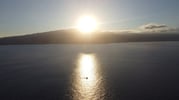
April 26, 2022
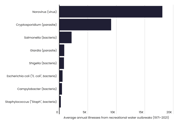
July 1, 2024
Related Articles
December 21, 2021
August 2, 2023
Featured Locations
- Fishing Charters Near Me
- Austin Fishing Guides
- Biloxi Fishing Charters
- Bradenton Fishing Charters
- Cabo San Lucas Fishing Charters
- Cancun Fishing Charters
- Cape Coral Fishing Charters
- Charleston Fishing Charters
- Clearwater Fishing Charters
- Corpus Christi Fishing Charters
- Crystal River Fishing Charters
- Dauphin Island Fishing Charters
- Daytona Beach Fishing Charters
- Destin Fishing Charters
- Fort Lauderdale Fishing Charters
- Fort Myers Fishing Charters
- Fort Walton Beach Fishing Charters
- Galveston Fishing Charters
- Gulf Shores Fishing Charters
- Hatteras Fishing Charters
- Hilton Head Fishing Charters
- Islamorada Fishing Charters
- Jacksonville Fishing Charters
- Jupiter Fishing Charters
- Key Largo Fishing Charters
- Key West Fishing Charters
- Kona Fishing Charters
- Lakeside Marblehead Fishing Charters
- Marathon Fishing Charters
- Marco Island Fishing Charters
- Miami Fishing Charters
- Montauk Fishing Charters
- Morehead City Fishing Charters
- Naples Fishing Charters
- New Orleans Fishing Charters
- New Smyrna Beach Fishing Charters
- Ocean City Fishing Charters
- Orange Beach Fishing Charters
- Panama City Beach Fishing Charters
- Pensacola Fishing Charters
- Pompano Beach Fishing Charters
- Port Aransas Fishing Charters
- Port Orange Fishing Charters
- Rockport Fishing Charters
- San Diego Fishing Charters
- San Juan Fishing Charters
- Sarasota Fishing Charters
- South Padre Island Fishing Charters
- St. Augustine Fishing Charters
- St. Petersburg Fishing Charters
- Tampa Fishing Charters
- Tarpon Springs Fishing Charters
- Venice Fishing Charters
- Virginia Beach Fishing Charters
- West Palm Beach Fishing Charters
- Wilmington Fishing Charters
- Wrightsville Beach Fishing Charters
